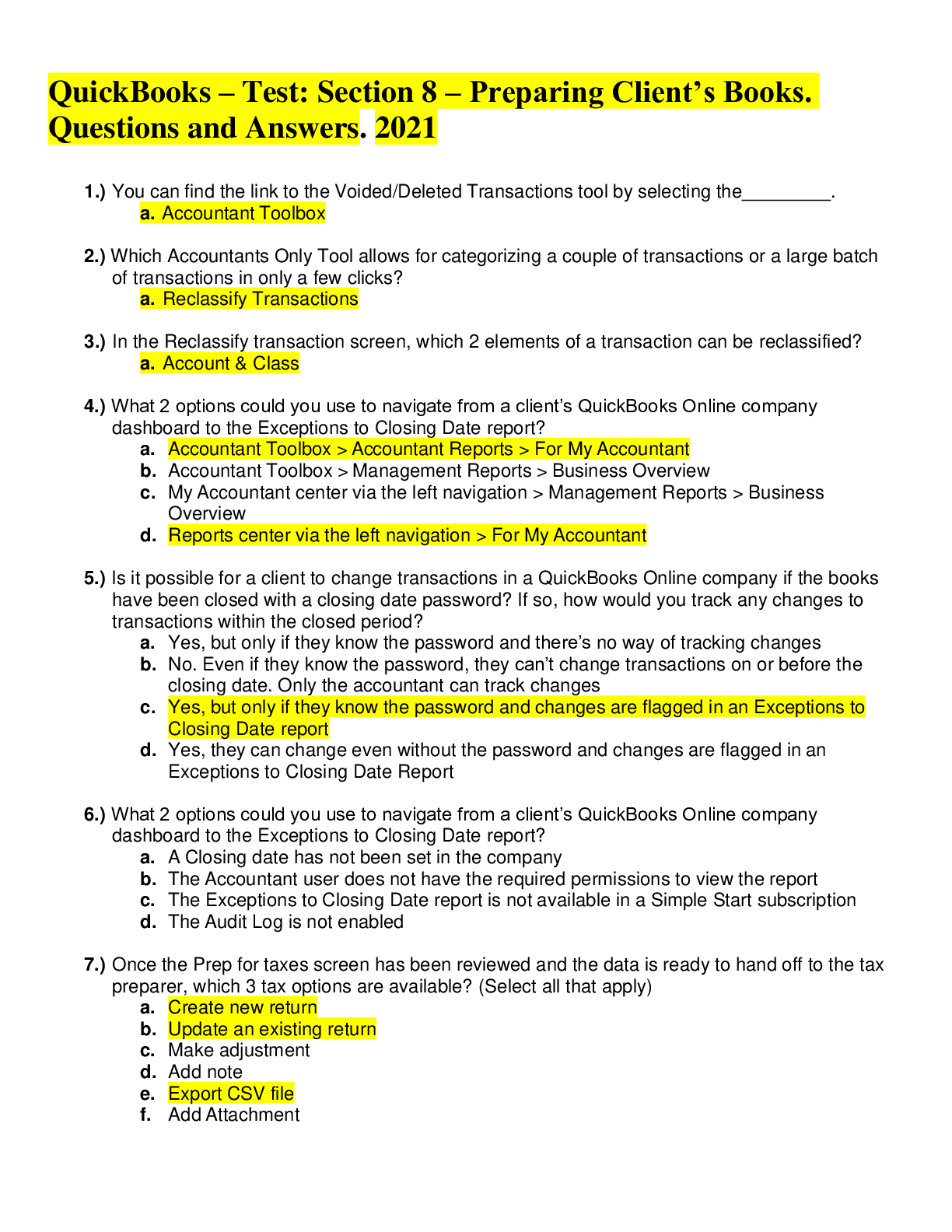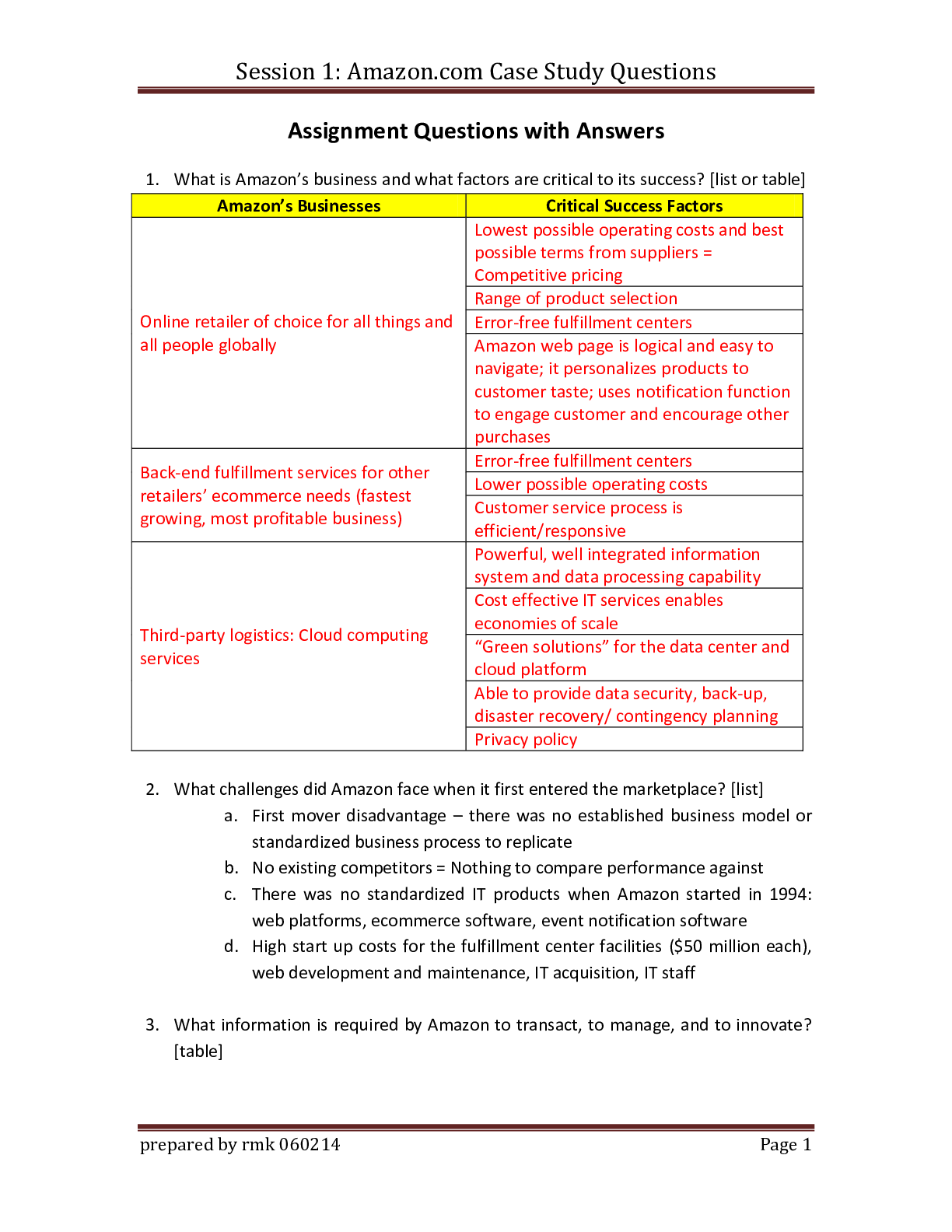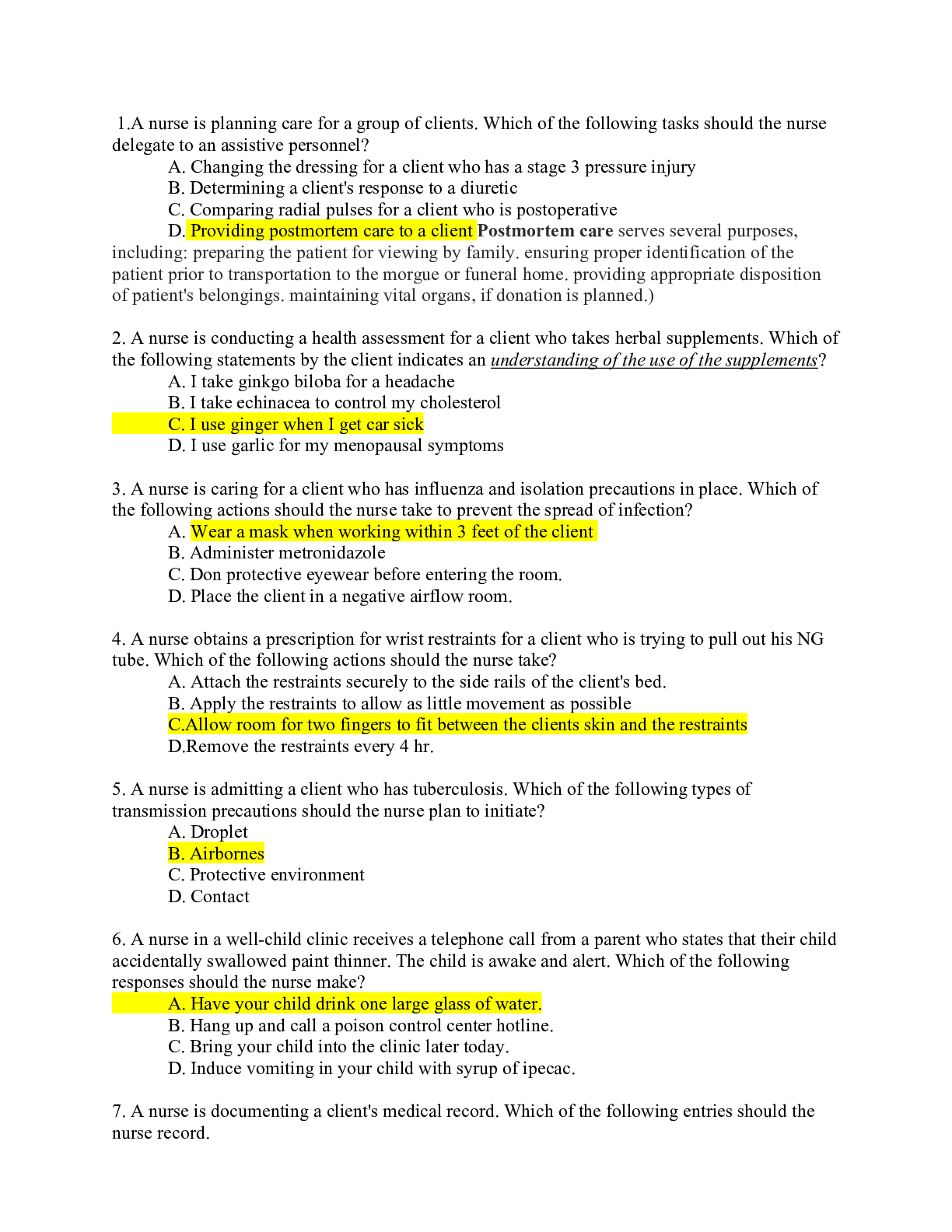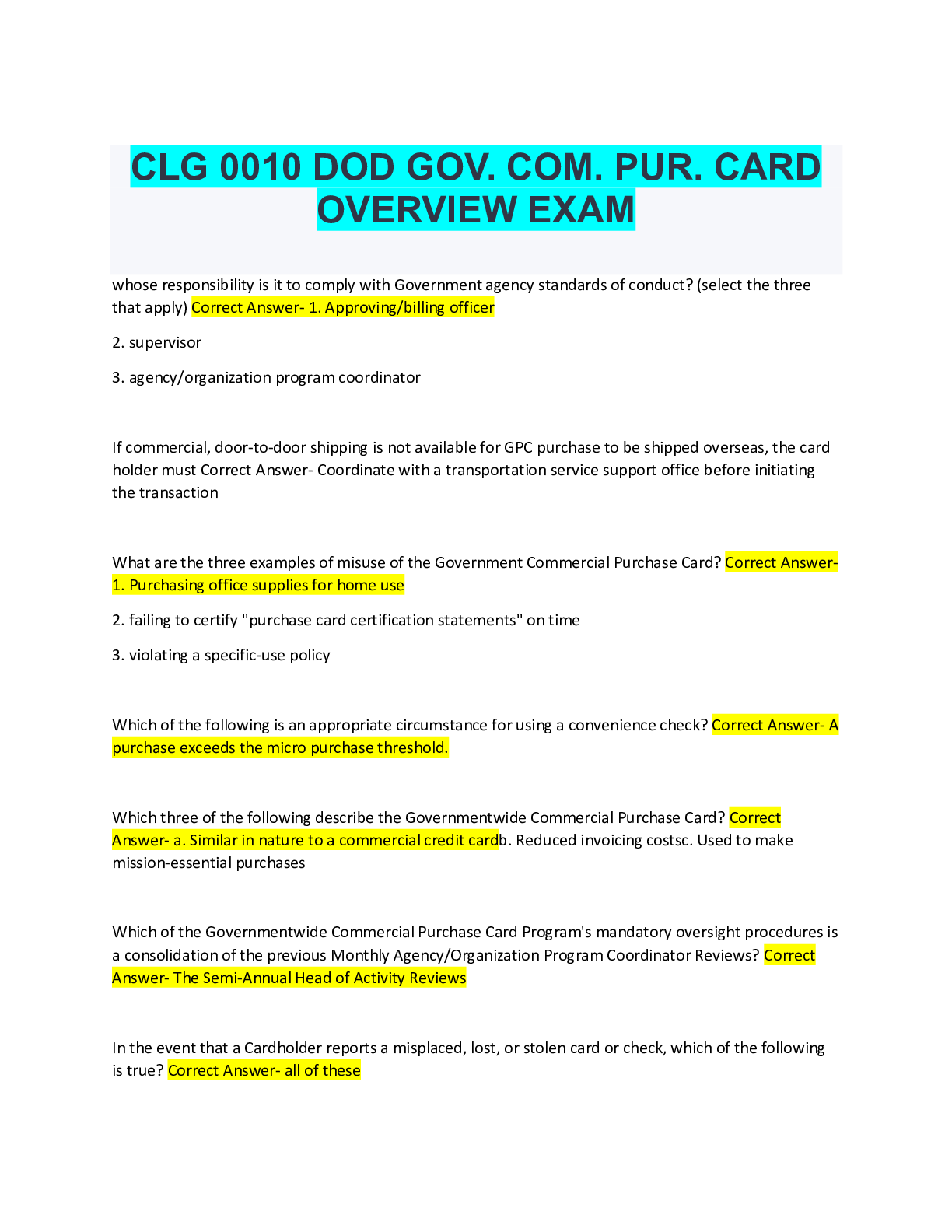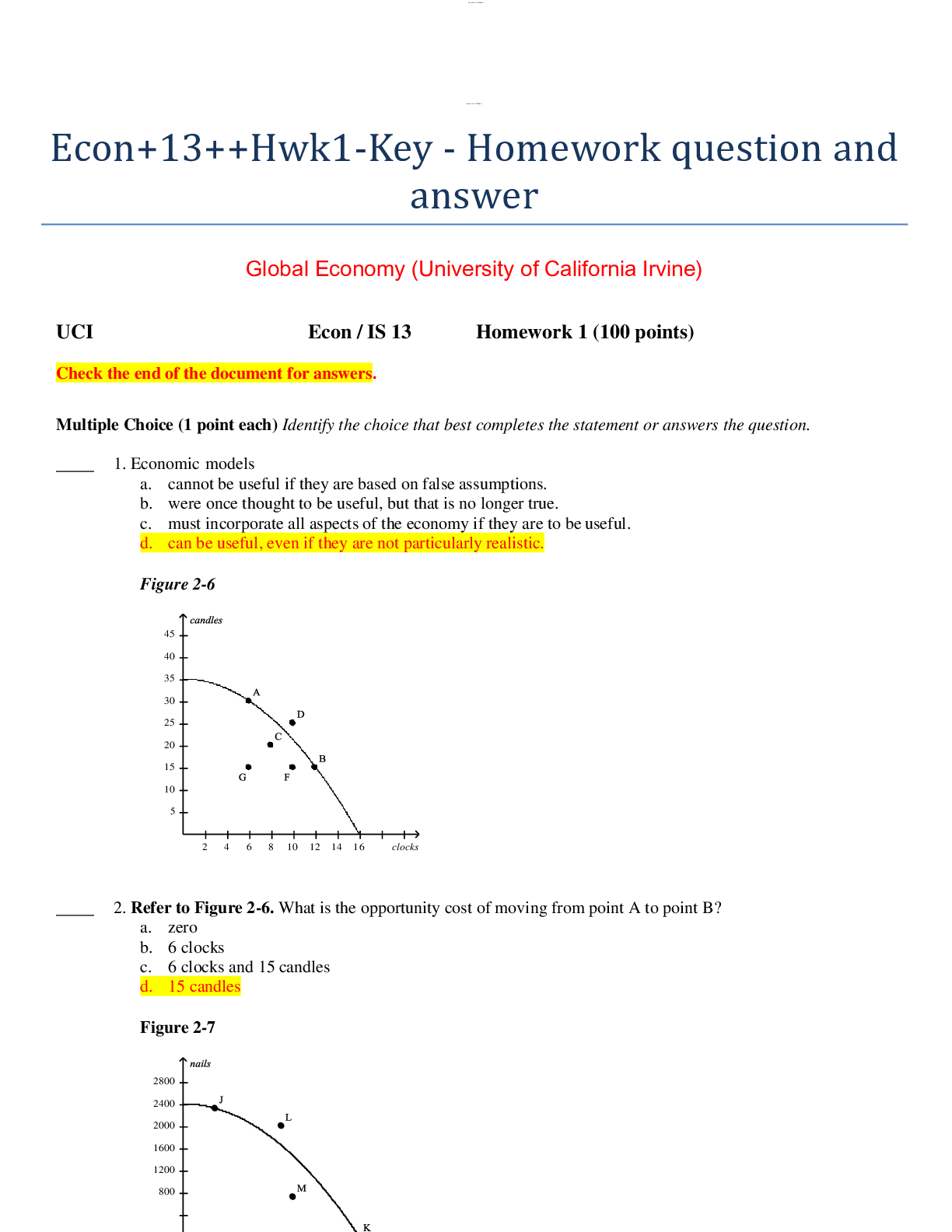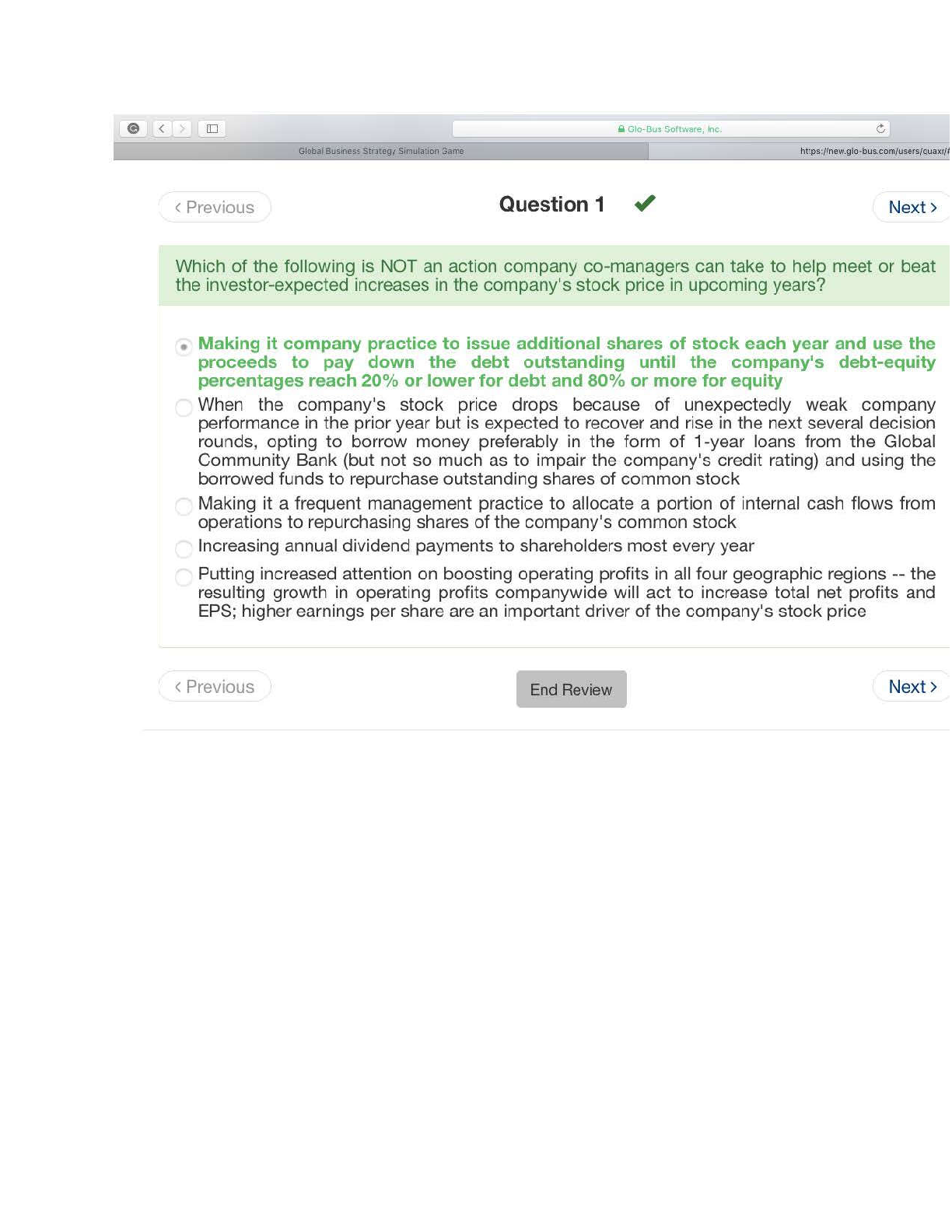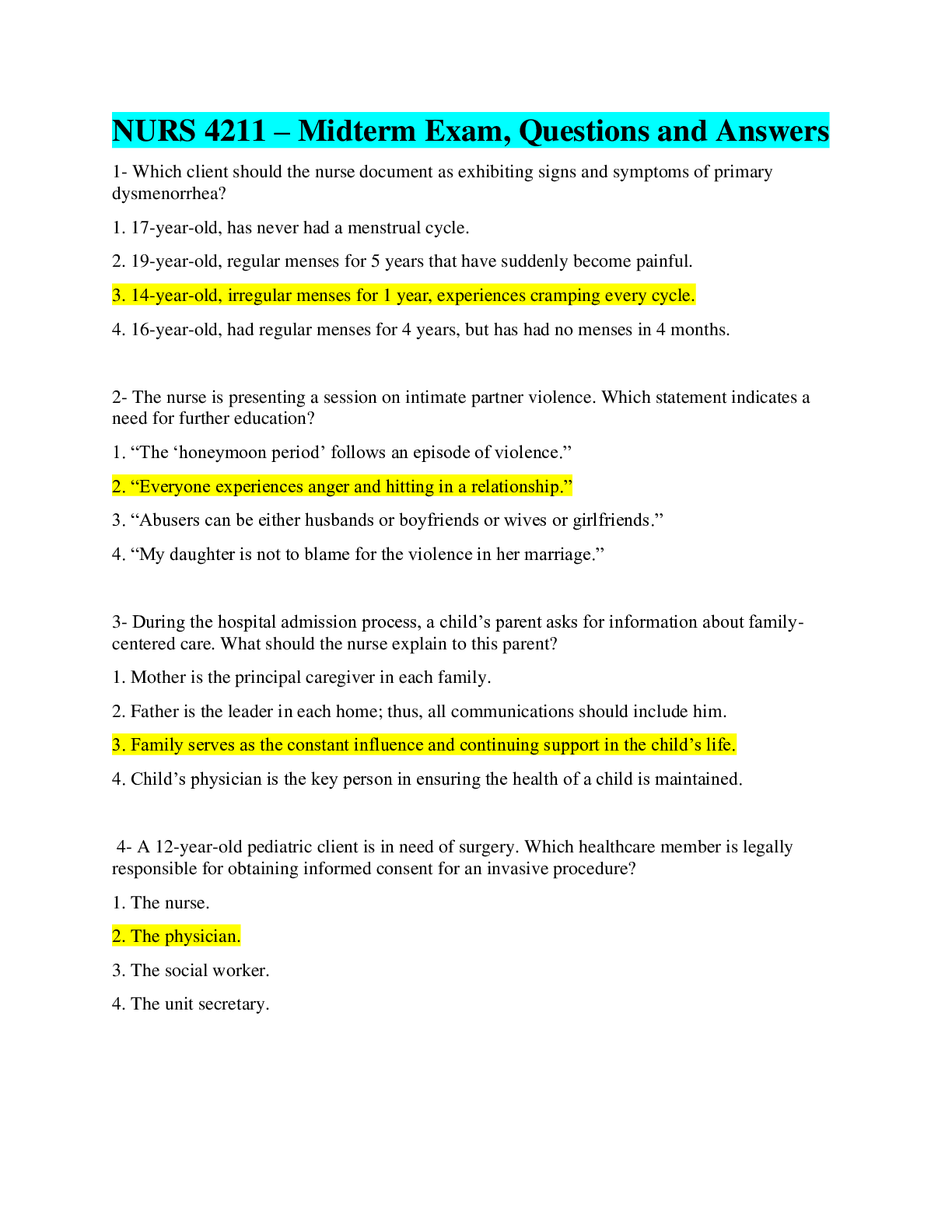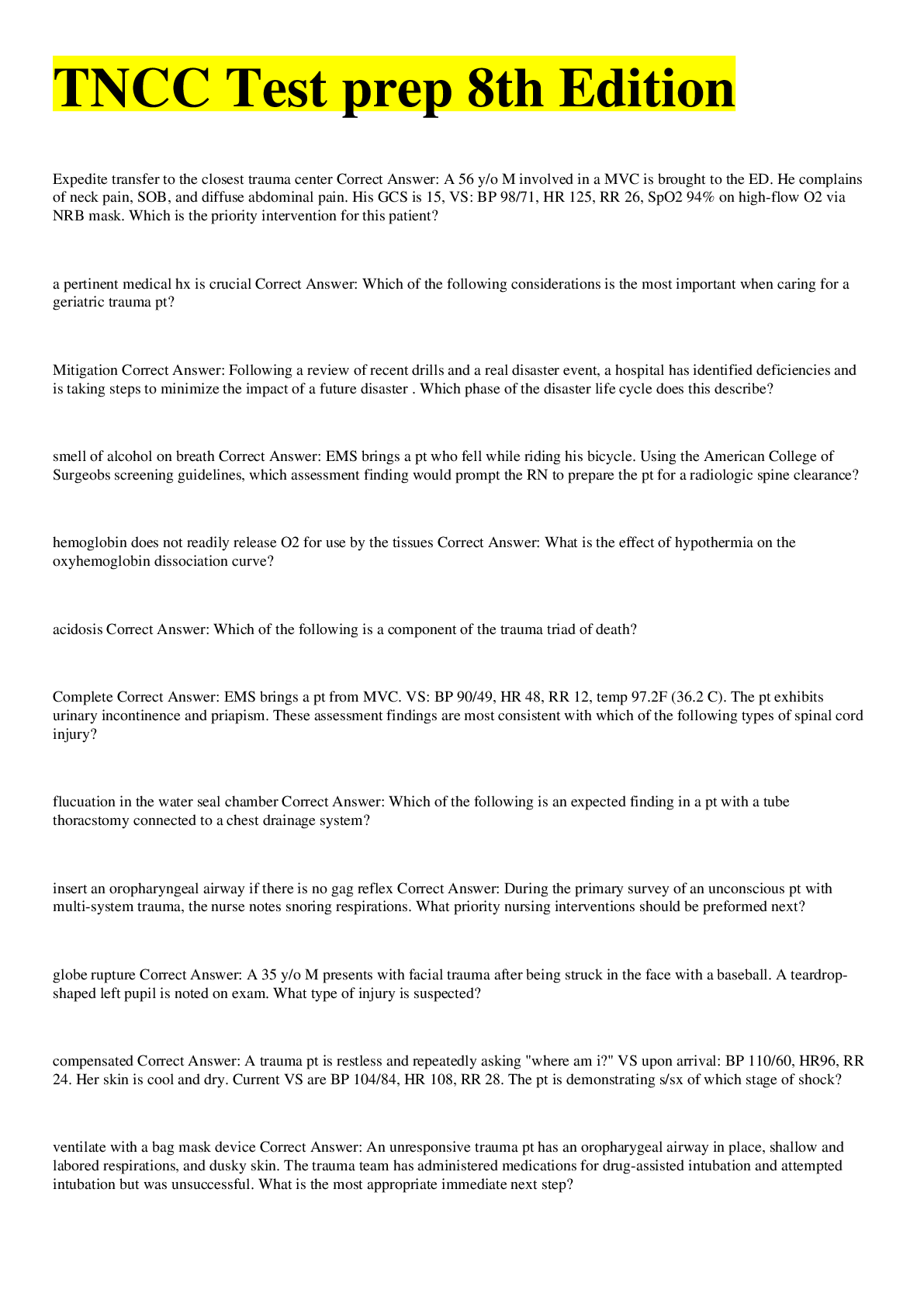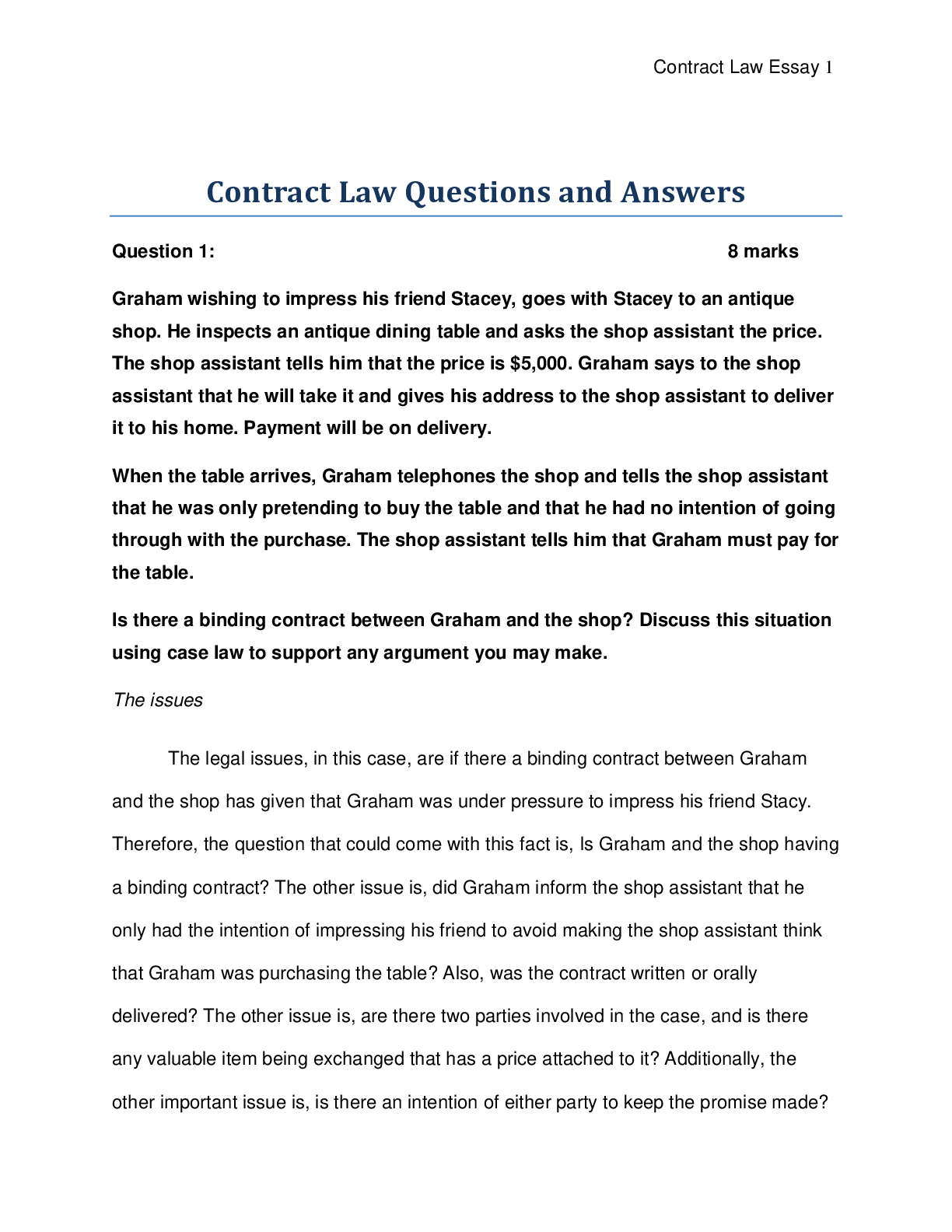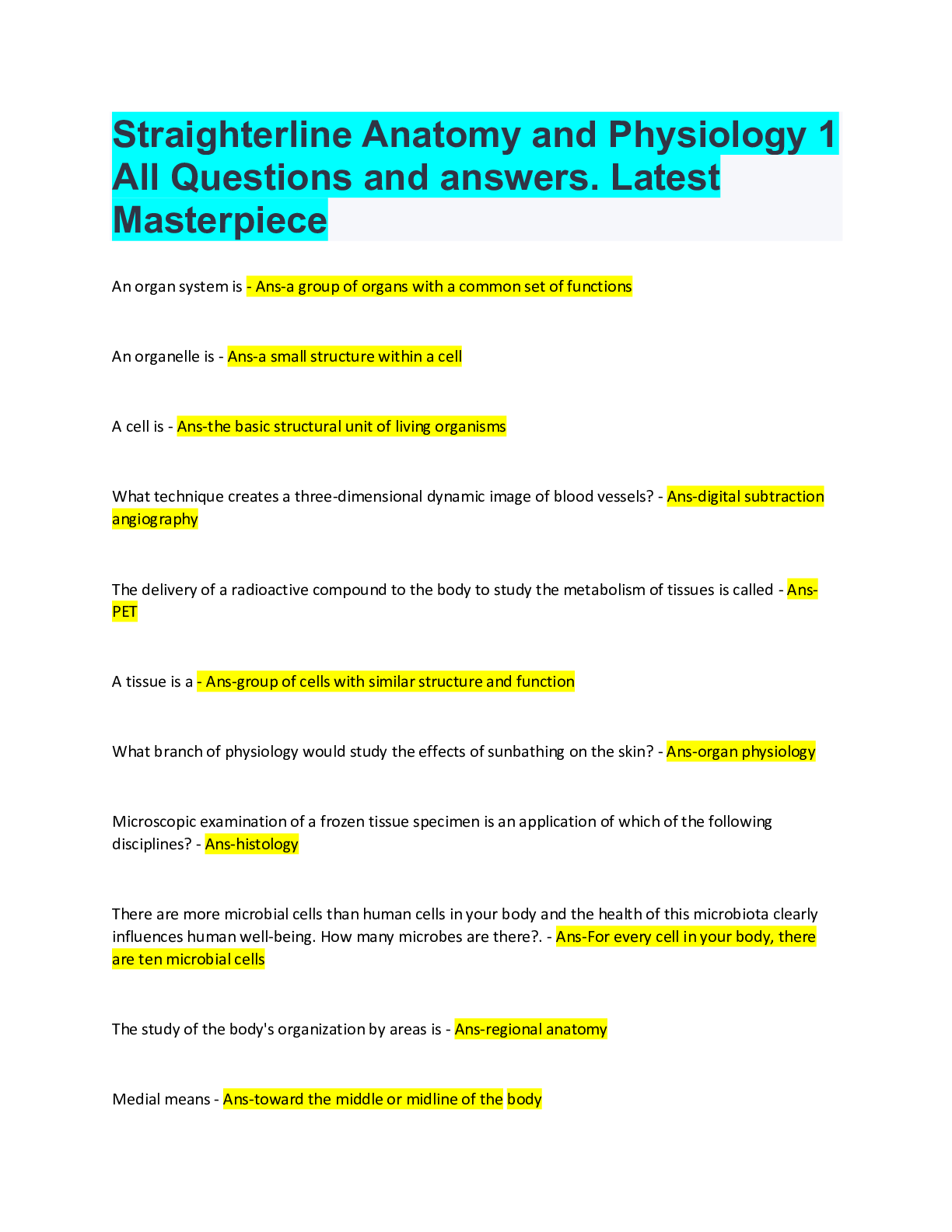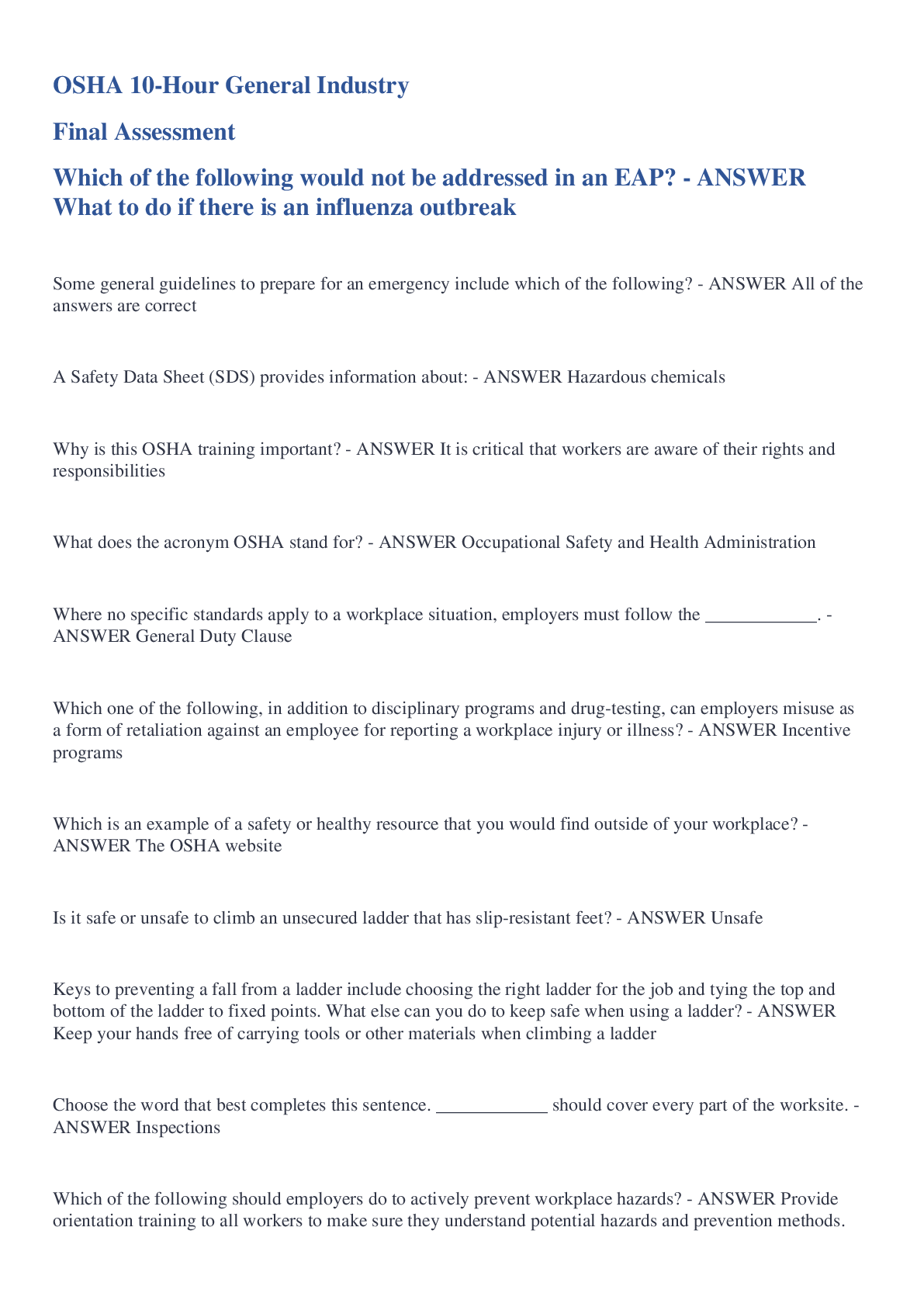Economics > QUESTIONS & ANSWERS > Middle Tennessee State University MBAE 6865 Economic Decisions for Managers. CHAPTER 6 Quiz. 50 Ques (All)
Middle Tennessee State University MBAE 6865 Economic Decisions for Managers. CHAPTER 6 Quiz. 50 Questions and Answers.
Document Content and Description Below
CHAPTER 6 Quiz Note: It is recommended that you save your response as you complete each question. Question 1 (1 point) The demand for a product is more inelastic Question 1 options: When it has ... many close substitutes In the long-run When it has many complements None of the above Save Question 2 (1 point) What is consumer surplus? Question 2 options: The maximum willingness to pay for a unit of a product The price that an individual pays in equilibrium for a product The difference between how much an individual is willing to pay for a product and how much he ends up paying How many units are traded in equilibrium Save Question 3 (1 point) As the price of dvds increases from $3 to $5, the quantity demanded falls from 220,000 to 180,000. The price elasticity of demand for dvds is: Question 3 options: -0.40 -0.33 -3.00 -2.50 Save Question 4 (1 point) If the current margin is greater than the desired margin, the firm should Question 4 options: Increase price Decrease price Not change the price Marginal revenue and marginal cost are both zero Save Question 5 (1 point)An rational, optimizing, self interested consumer would consume up to the point where Question 5 options: the consumer surplus from the last unit is positive the consumer surplus from the last unit is negative the consumer surplus from the last unit is zero none of the above Save Question 6 (1 point) The first law of demand states that Question 6 options: the quantity demanded increases as price falls the quantity demanded decreases as price falls the quantity demanded increases as price increases none of the above Save Question 7 (1 point) Which of the following is false? Question 7 options: Products with more close substitutes have more elastic demand The demand for any individual brand is less elastic than industry aggregate demand Products with many complements have less elastic demand In the long run, demand curves become more elastic Save Question 8 (1 point) If potatoes are inferior goods, which of the following will increase the demand for potatoes? Question 8 options: Increase in the price of a complement Decrease in income Decrease in the price of a substitute Increase in income Save Question 9 (1 point) If the current margin is greater than the desired margin, the firm should Question 9 options: Increase production I believe this is the correct answer. Decrease productionNot change production level WRONG Production ceases Save Question 10 (1 point) In general, the larger the price elasticity: Question 10 options: the smaller the responsiveness of price to changes in quantity. the smaller the responsiveness of quantity to changes in price. the larger the responsiveness of price to changes in quantity. the larger the responsiveness of quantity to changes in price. Save Question 11 (1 point) A perfectly elastic demand curve Question 11 options: Is a horizontal line parallel to the x axis Has an elasticity of demand between 0 and 1 Is the demand curve of a product that usually has no substitutes None of the above Save Question 12 (1 point) What is an aggregate demand curve Question 12 options: The demand of an individual with respect to price The total demand of the market with respect to price of a good The preference of an individual in the market None of the above Save Question 13 (1 point) A demand curves describes Question 13 options: the amount of units a consumer will purchase at a given price the amount of units a producer will sell at a given price both the amount of units that a consumer will buy and a producer will produce at a given price the amount of units supplied given a change in prices Save Question 14 (1 point) For substitutes, cross price elasticity of demand is:Question 14 options: Negative Positive between zero and one only zero. Save Question 15 (1 point) If the current margin is greater than the desired margin, Question 15 options: MR=MC MR>MC MR Marginal revenue and marginal cost are both zero Save Question 16 (1 point) The price elasticity of demand for a printer is estimated to be 1 . This means that an increase in price by 10% will Question 16 options: Increase quantity demanded by 10% Decrease quantity demanded by 10% Increase demand by 10% Decrease demand by 10% Save Question 17 (1 point) The demand for Nike shoes is _________________ than the demand for shoes in general. Question 17 options: More elastic More inelastic Less elastic Less inelastic Save Question 18 (1 point) The income elasticity of demand for housing property is exactly 1.40. Due to a recession, you expect incomes to drop by 5% next year. How will consumers adjust their purchase for housing property? Question 18 options: Buy 5% more houses Buy 5% fewer housesBuy 7% more houses Buy 7% fewer houses Save Question 19 (1 point) The owner of a bakery decides to drop the price of lemon cakes by 5%, how much does quantity sold have to rise to stop the revenue from decreasing Question 19 options: 2% 3% 4% 5% Save Question 20 (1 point) An owner of a local salon realized that by decreasing the prices that she charges for haircuts, her revenue has increased. This implies that Question 20 options: The demand for her haircuts is elastic The demand for her haircuts is inelastic The demand for her haircuts is unitary elastic The demand for her haircuts is perfectly inelastic Save Quiz Note: It is recommended that you save your response as you complete each question. Question 1 (1 point) What criteria do consumers apply when deciding whether or not to consume Question 1 options: The consumer would consume only if the price is lower than his highest willingness to pay The consumer would only consume if his surplus is greater than zero The consumer would only consume if the price is higher than his highest willingness to pay Both A&B Save Question 2 (1 point) What is a normal good? Question 2 options: A good whose demand increases when income decreases A good whose demand decreases when income decreasesA good whose demand increases when price increases Both B&C Save Question 3 (1 point) The demand for a product is more elastic Question 3 options: When it has few substitutes In the long-run When the expenditure on the product represent a small portion of the budget When the product is broadly defined Save Question 4 (1 point) A price elasticity of demand of 2.3 implies Question 4 options: Demand is inelastic Demand is elastic Demand is unitary elastic Demand is perfectly elastic Save Question 5 (1 point) If the price elasticity of demand is -0.8 and the firm decreases price, revenue will Question 5 options: Increase Decrease Stay constant become zero, they would lose all their customers Save Question 6 (1 point) If cars are normal goods, a fall in income will Question 6 options: Increase the demand for cars Decrease the demand for cars Have no effect on the demand for cars None of the above Save Question 7 (1 point) As price increases, demand typicallyQuestion 7 options: becomes more elastic WRONG – Credit Given, he says it’s right becomes less elastic does not change elasticity does not change best guess at the “correct” incorrect answer Save Question 8 (1 point) Which of the following statements is true Question 8 options: A firm should increase quantity as long as average cost is greater than price A firm should increase quantity as long as price is greater than marginal cost A firm should increase quantity as long as price is higher than average cost, regardless of the marginal cost A firm should increase quantity as long as marginal cost is greater than price Save Question 9 (1 point) The price elasticity of demand tells us about Question 9 options: The sensitivity of price to quantity The sensitivity of quantity to price The sensitivity of income to price The sensitivity of income to quantity Save Question 10 (1 point) Which of the following statement is true? Question 10 options: The demand for Cheerios is less elastic than the demand for cereal The demand for gas is more elastic in the short-run than in the long-r The demand for puma shoes is more elastic than the demand for shoes Products with many complements have a more elastic demand Save Question 11 (1 point) If the price elasticity of demand is -0.8 and the firm increases price, revenue will Question 11 options: Increase Decrease Stay constant become zero, they would lose all their customersSave Question 12 (1 point) A price elasticity of demand of -0.67 implies Question 12 options: Demand is inelastic Demand is elastic Demand is unitary elastic Demand is perfectly elastic Save Question 13 (1 point) For complements, cross price elasticity of demand is: Question 13 options: Negative Positive between zero and one only zero. Save Question 14 (1 point) In general, the smaller the price elasticity: Question 14 options: the smaller the responsiveness of price to changes in quantity. the smaller the responsiveness of quantity to changes in price. the larger the responsiveness of price to changes in quantity. the larger the responsiveness of quantity to changes in price. Save Question 15 (1 point) The quantity demanded of good X falls by 20% and, in response, your income goes down by 10% and, the income elasticity of demand would be: Question 15 options: 2 4 .5 .20 Save Question 16 (1 point) Jim saw a decrease in the quantity demanded for his firm’s product from 8000 to 6000 units a week when he raised the price of the product from $200 to $250. Based on this information, the price elasticity of demand for Jim’s product isQuestion 16 options: >1 1 <1 0 Save Question 17 (1 point) If a decrease in the price of a good decreases the total revenue, the demand for the good is Question 17 options: price elastic price inelastic income elastic income inelastic Save Question 18 (1 point) Its lunch time, you are hungry and would like to have some pizza. By the law of diminishing marginal value, Question 18 options: you would pay more for your first slice of pizza than your second you would pay more for your second slice of pizza than your first you would pay an equal amount of money for both the slices since they are identical none of the above Save Question 19 (1 point) As the number of substitutes for a good increases, the absolute value of its own-price elasticity Question 19 options: stays the same increases decreases the good becomes perfectly inelastic. Save Question 20 (1 point) An economist estimated the cross-price elasticity for peanut butter and jelly to be -1.5. Based on this information, we know the goods are Question 20 options: inferior goods. complements. inelastic.substitutes. Save CHAPTER 7 Quiz Note: It is recommended that you save your response as you complete each question. Question 1 (1 point) Diseconomies of scale are also known as Question 1 options: Increasing returns to scale Decreasing returns to scale Constant returns to scale None of the above Save Question 2 (1 point) Learning curves mean Question 2 options: you learn from experience current production decreases future unit costs production today leads to lower costs in the future All of the above Save Question 3 (1 point) If marginal costs rises above average costs, average costs must Question 3 options: Be increasingBe decreasing Stay constant None of the above Save Question 4 (1 point) Average costs curves rise with production Question 4 options: Due to declining average fixed costs Due to rising average fixed costs Due to marginal costs being less than average costs Due to rising marginal costs Save Question 5 (1 point) What are economies of scope? Question 5 options: lower average costs when multiple different products are produced higher average costs when multiple different products are produced Constant average costs when multiple different products are produced none of the above Save Question 6 (1 point) All of these could be sources of economies of scale except Question 6 options: Investment in more efficient technologySpecialization A bottleneck procedure Discounts on bulk purchase of inputs Save Question 7 (1 point) If long run average costs rise with output, you have Question 7 options: Increasing returns to scale Decreasing returns to scale Constant returns to scale None of the above Save Question 8 (1 point) Average costs curves initially fall Question 8 options: Due to declining average fixed costs Due to rising average fixed costs Due to rising fixed costs Due to rising marginal costs Save Question 9 (1 point) Which of the following is true Question 9 options: Increasing output always leads to increase in profitsIncreasing outputs increase profits if price is above marginal cost Increasing output increases profits if price is lea than marginal costs Increasing output always decreases profits Save Question 10 (1 point) If marginal costs fall below average cost, average cost must be Question 10 options: Be increasing Be decreasing Stay constant None of the above Save Question 11 (1 point) What are economies of scope? Question 11 options: the cost of producing two products jointly by one firm is more than the cost of producing them separately the cost of producing two products jointly by one firm is lesser than the cost of producing them separately the cost of producing two products jointly by one firm is equal to the cost of producing them separately none of the above Save Question 12 (1 point) Diminishing marginal productivity implies Question 12 options: decreasing marginal costsincreasing marginal costs decreasing average costs decreasing total costs Save Question 13 (1 point) All the factors below are causes of diminishing marginal returns, except Question 13 options: Difficulty of monitoring and motivating larger workforces Increasing complexity of larger systems Specialization and division of Labor The “fixity’ of some factor Save Question 14 (1 point) Once marginal costs rise above the average cost, Question 14 options: Average cost increases Average cost decreases Average costs will stay the same None of the above Save Question 15 (1 point) What is a synergy or cost complementarity? Question 15 options: WRONG. Best guess is C since A&B are identical. the cost of producing different products offered by separate companies would be more expensive when produced by one companythe cost of producing different products offered by separate companies is higher than when produced by one company correct answer the cost of producing different products offered by separate companies is equal to when the products are produced by one company None of the above Save Question 16 (1 point) A firewood supplier has a very seasonal demand for its product. Its transport trucks lay idle during the warmer parts of the year. It can exploit economies of scope if Question 16 options: It merges with a manufacturer of wooden Christmas ornaments It turns into a rental trucking company during the warmer months for other seasonal producers such as ice-cream makers It starts producing other seasonal products that would sell mostly during the warmer months such as rustic lawn chairs B and C Save Question 17 (1 point) Eddys’ Electronics found that instead of producing a dvd player and a gaming system separately, it is cheaper to incorporate dvd playing capabilities in their new version of the gaming system. Eddy’s is taking advantage of Question 17 options: Economies of Scale Learning curve Economies of Scope Decreasing marginal costs Save Question 18 (1 point) When a firm’s marginal productivity declines as output increases, then the firm is experiencing Question 18 options:Diminishing returns to scale Constant returns to scale Increasing returns to scale Increasing marginal product Save Question 19 (1 point) You would expect that your firm is experiencing increasing returns to scale if Question 19 options: Long run average costs increase with output Long run average costs decrease with output Long run average costs are constant with respect to output None of the above Save Question 20 (1 point) A firm experiencing constant economies of scale will have a long-run average cost curve that is: Question 20 options: upward sloping vertical downward sloping horizontal Save CHAPTER 8Quiz Note: It is recommended that you save your response as you complete each question. Question 1 (1 point) An increase in demand could arise from which of the following factors Question 1 options: an increase in income a decrease in the price of a substitute an increase in the price of a complement all of the above Save Question 2 (1 point) Demand and supply analysis is particularly important if Question 2 options: the success of your firm is closely linked to the profitability of your primary industry the success of your firm is independent of the profitability of your primary industry the success of your firm is unlikely demand and supply analysis is unimportant Save Question 3 (1 point) A decrease in the price of a complement shifts the demand curve to the Question 3 options: right left it does not change the demand curvenone of the above Save Question 4 (1 point) An increase in income causes the demand of normal goods to _________ and the price of normal goods to Question 4 options: Increase; increase Increase; decrease Decrease; increase Decrease, decrease Save Question 5 (1 point) An increase in the price of a substitute shifts the demand curve to the _______ Question 5 options: right left it does not change the demand curve none of the above Save Question 6 (1 point) If a firm can create important complements to its original product, it has Question 6 options: Created an uncontrollable factor that can change the demand for its product Created an uncontrollable factor that cannot change the demand for its product Created a controllable factor that can change the demand for its productCreated a controllable factor that cannot change the demand for its product Save Question 7 (1 point) The change in quantity demanded derived from a change in price is Question 7 options: the movement along a demand curve the movement along a supply curve a shift in the demand curve a shift in the supply curve Save Question 8 (1 point) Changes in the price of a product can cause Question 8 options: A movement along the demand curve A shift of the demand curve A shift of the supply curve All of the above Save Question 9 (1 point) All these factors would shift the supply curve of tobacco, except Question 9 options: Bad weather Change in the price of tobacco Changes in the wages of agricultural workersA tax charged on the production of tobacco Save Question 10 (1 point) Which of the following would shift the supply of Florida Oranges to the left? Question 10 options: a hurricane in Florida destroying a major part of the crop an increase in the price of water per unit, a major input, used to irrigate the orange trees one of the orange grooves shuts down all of the above Save Question 11 (1 point) The information conveyed by changes in market prices is especially important in financial markets because Question 11 options: It forces individual investors to reveal their information about the prospects of a security It assesses business decisions It helps firms forecast the future demand for products All of the above Save Question 12 (1 point) Which of the following factors would shift the supply curve for ice cream to the right? Question 12 options: a new cooling technology emerges the price per unit increases the number of producers in the market for ice cream increaseBoth A&C Save Question 13 (1 point) The law of supply states that, holding other factors constant, as price increases Question 13 options: Quantity supplied increases Quantity supplied decreases Quantity demanded increases Quantity demanded decreases Save Question 14 (1 point) An increase in demand could arise from which of the following factors Question 14 options: an increase in income a decrease in the price of a complement an increase in the price of a substitute all of the above Save Question 15 (1 point) An increase in the price of a complement shifts the demand curve to the Question 15 options: right left it does not change the demand curvenone of the above Save Question 16 (1 point) How does an increase in income affect the market for bus rides (inferior good)? Question 16 options: The demand curve for bus rides to shift to the right The demand curve for bus rides to shift to the left The supply curve for bus rides to shift to the right The supply curve for bus rides to shift to the left Save Question 17 (1 point) In the market for used cars we have 10 sellers, willing to sell at the prices of $1000, $2000, $3000, $4000, $5000, $6000, $7000, $8000, $9000, $10000. If the equilibrium price in the market is $2500, how many cars would be sold? Question 17 options: 1 2 3 4 Save Question 18 (1 point) As the income of bus riders increased, the wages of bus drivers increased simultaneously. How does this affect the market for bus rides (inferior good)? Question 18 options: The demand curve will shift to the left; the supply curve will shift to the left The demand curve will shift to the left; the supply curve will shift to the rightThe demand curve will shift to the right; the supply curve will shift to the left The demand curve will shift to the right; the supply curve will shift to the right Save Question 19 (1 point) How does an increase in income affect the market for iPads (normal good)? Question 19 options: The demand curve for iPads shifts to the right The demand curve for iPads shifts to the left The supply curve for iPads shifts to the right The supply curve for iPads shifts to the left Save Question 20 (1 point) Suppose there are 11 buyers and 11 sellers, each willing to buy or sell one unit of a good, with values {$14, $13, $12, $11, $10, $9, $8, $7, $6, $5, $4,}. Assume no transaction costs and a competitive market, what is the equilibrium price in this market? Question 20 options: 7 8 9 WRONG – no idea on correct answer. 10 Correct “incorrect” answer SaveCHAPTER 9 Quiz CH 9 Note: It is recommended that you save your response as you complete each question. Question 1 (1 point) A sudden fall in the market demand in a competitive industry leads to Question 1 options: A short run market equilibrium price lower than the original equilibrium A market equilibrium price higher than the short run price Some firms exiting the market All of the above Save Question 2 (1 point) Which of the following markets are closest to perfectly competitive Question 2 options: The market for smart phones The market for generic pharmaceuticals PROBABLY RIGHT The market for sport shoes The market for fast food WRONG Save Question 3 (1 point) A sudden fall in the market demand in a competitive industry leads to Question 3 options: A short run market equilibrium price higher than the original equilibrium A market equilibrium price lower than the short run priceSome firms exiting the market All of the above Save Question 4 (1 point) In the long run, in a competitive industry Question 4 options: economic profits are zero firms break even price equals average cost all of the above Save Question 5 (1 point) In equilibrium the typical investor __________ Question 5 options: prefers high risk assets to low risk assets prefers low risk assets to high risk assets is indifferent between buying low and high risk assets does not stay in the market Save Question 6 (1 point) A risk premium is Question 6 options: the difference between the earnings of a low risk asset and a high risk asset WRONG premium paid to a security holder to compensate him for bearing a higher riskboth A&B Correct answer none of the above Save Question 7 (1 point) In a monopoly Question 7 options: WRONG the industry has high barriers to entry the industry has high barriers to exit the industry has high barriers to entry and exit THIS IS THE CORRECT ANSWER the industry has no barriers to entry or exit Save Question 8 (1 point) In a competitive industry Question 8 options: the industry has high barriers to entry the industry has high barriers to exit the industry has high barriers to entry and exit the industry has no barriers to entry or exit Save Question 9 (1 point) A sudden rise in the market demand in a competitive industry leads to Question 9 options: A short run market equilibrium price lower than the original equilibrium A market equilibrium higher than the short run priceEntry of new firms into the market All of the above Save Question 10 (1 point) In equilibrium, high risk stocks would typically be accompanied by Question 10 options: low returns no returns high returns no sales-no one would buy risky stocks Save Question 11 (1 point) The concept of mean reversion is defined by Question 11 options: the tendency of profits to revert to zero the tendency of costs to revert to zero the tendency of economic profits to revert to zero the tendency of profits to revert to negative Save Question 12 (1 point) A sudden decrease in the market demand in a competitive industry leads to Question 12 options: Losses in the short-run and average profits in the long-run Above average profits in the short-run and average profits in the long-runNew firms being attracted to the industry Demand creating supply Save Question 13 (1 point) A sudden increase in the market demand in a competitive industry leads to Question 13 options: Losses in the short-run and average profits in the long-run Above average profits in the short-run and average profits in the long-run New firms being attracted to the industry Both B&C Save Question 14 (1 point) In the long run, a monopoly’s Question 14 options: economic profits are zero economic profits are negative economic profits are positive demand is perfectly inelastic Save Question 15 (1 point) A sudden fall in the market demand in a competitive industry leads to Question 15 options: A short run market equilibrium price higher than the original equilibrium A market equilibrium price higher than the short run priceNew firms entering the market All of the above Save Question 16 (1 point) In equilibrium, low risk assets earn a _______return than high risk assets Question 16 options: higher lower similar none of the above Save Question 17 (1 point) Lipitor, a heart medication with few substitutes, should have an own-price elasticity of demand that is: Question 17 options: Relative elastic Relatively inelastic Perfectly inelastic Perfectly elastic Save Question 18 (1 point) According to the indifference principle, in the long run if being a teacher is more desirable than being a garbage collector, Question 18 options: teachers would be paid a relatively higher salary than garbage collectorsteachers would be paid a relatively lower salary than garbage collectors teachers and garbage collectors would both be paid the same wages none of the above Save Question 19 (1 point) The main reason(s) monopolies can earn positive profits for a while is(are) Question 19 options: assets cannot quickly move in and out of the industry when demand fluctuates an increase in demand does not lead to entry of firms to absorb the extra demand both A&B none of the above Save Question 20 (1 point) A sudden increase in the market demand in a competitive industry leads to Question 20 options: A market equilibrium profits higher than the original equilibrium in the short-run A market equilibrium profits equal to the original equilibrium in the long-run Both a and b None of the above Save Quiz CH 9 Note: It is recommended that you save your response as you complete each question. Question 1 (1 point)The indifference principle states that Question 1 options: If an asset is mobile, then in the long run, it will be indifferent about where it is used In the long run, a mobile asset will make the same profit, no matter where it goes If an asset is mobile, then in the long run, it would stay with the first user Only A&B Save Question 2 (1 point) In a competitive industry, the competitive firm’s profits are Question 2 options: independent of the industry in which they compete closely linked to the industry in which they compete determined only by their own differentiated product determined solely by the inelastic demand for their product Save Question 3 (1 point) In the short-run, a monopoly is most likely to achieve Question 3 options: An average rate of return Above average profits Economic Profits Both B&C Save Question 4 (1 point)Which of the following is least like a monopoly Question 4 options: Twitter YouTube WRONG Facebook Google Save Question 5 (1 point) Critical care surgeons get paid higher salaries than family doctors because Question 5 options: they usually work under highly stressful conditions they usually have to get longer training they usually work uncertain hours all of the above Save Question 6 (1 point) All these are characteristics of a monopoly except, Question 6 options: There is one seller of the product Has few substitutes Controls a large share of the market Controls a small share of the market Save Question 7 (1 point)Which of the following cannot be classified as a market structure? Question 7 options: Perfect Competition Monopoly All of the above None of the above WRONG Save Question 8 (1 point) A sudden decrease in the market demand in a competitive industry leads to Question 8 options: A market equilibrium price higher than the original equilibrium in the short-run A market equilibrium price equal to the original equilibrium in the long-run Both a and b None of the above Save Question 9 (1 point) Low risk stocks are usually accompanied by Question 9 options: low returns no returns high returns no sales-no one would buy low risk stocks Save Question 10 (1 point)According to the indifference principle, housing prices Question 10 options: tend to converge over time tend to leave individuals indifferent about where they live only tend to be different to compensate individuals for differences in living conditions only B&C Save Question 11 (1 point) All of these are characteristics of a competitive industry, except: Question 11 options: Many substitutes No barriers to entry Homogenous product Little or no information on rivals’ products Save Question 12 (1 point) A monopoly has Question 12 options: A perfectly elastic demand curve A perfectly elastic supply curve An inelastic demand curve A less elastic demand curve than a competitive firm Save Question 13 (1 point)A compensating wage differential is Question 13 options: the difference between the wage of an individual working in favorable conditions and the wage of an individual working in unfavorable conditions compensation paid to an individual for working in a less desirable environment premium paid to a security holder to compensate him for bearing a higher risk Only A&B Save Question 14 (1 point) In a competitive industry Question 14 options: firms have no cost advantages some firms have cost advantages, while others do not all the firms have highly differentiated products Consumers have strong preferences across brands Save Question 15 (1 point) A sudden rise in the market demand in a competitive industry leads to Question 15 options: A short run market equilibrium price higher than the original equilibrium A market equilibrium lower than the short run price Entry of new firms into the market All of the above Save Question 16 (1 point)In the long run, if housing prices are higher in San Diego, California, versus Nashville, Tennessee, then Question 16 options: individuals would move to Nashville individuals would move San Diego there would be no movement across the two cities, since the difference in prices is pure compensation for difference in living conditions Both B&C Save Question 17 (1 point) A firm in a ______________ faces a __________ demand curve. Question 17 options: perfectly competitive market; perfectly inelastic perfectly competitive market; perfectly elastic monopoly market; perfectly elastic monopoly market; horizontal Save Question 18 (1 point) Alan is offered a gamble. Heads he wins $100, tails he wins $20. If the game costs $60, would he play? Question 18 options: Yes he would play since the expected value is equal to the price of the play Yes he would play since the expected value of the play is higher than the price of the play No he would not play since the price of the play is higher than the expected value No he would not play since this is a fair bet and he is not being offered any risk premium Save Question 19 (1 point)Nike faces a more__________ demand for its products than a shoe polish producer. Question 19 options: Inelastic THIS MUST BE RIGHT Elastic WRONG perfectly elastic perfectly inelastic Save Question 20 (1 point) The main reason(s) firms in a competitive market cannot earn positive profits in the long run is(are) Question 20 options: assets can quickly move in and out of the industry when demand fluctuates an increase in demand leads to entry of firms which absorb the extra demand a decrease in demand leads to exit of firms from the market such that there is no surplus all of the above Save Quiz CHAPTER 10 Note: It is recommended that you save your response as you complete each question. Question 1 (1 point) Which of the following makes a firm’s resources hard to imitate? Question 1 options: They don’t flow from the firm’s unique history The link between resources and advantages is difficult to discern They aren’t socially complexAll of the above Save Question 2 (1 point) Supplier power tends to be low when Question 2 options: The supplier provides non-critical inputs The supplier provides homogenous inputs Both A&B None of the above Save Question 3 (1 point) In the IO perspective, it is important to enter an industry with Question 3 options: High barriers to entry Low buyer power Low supplier power All of the above Save Question 4 (1 point) The five forces model is a framework Question 4 options: For increasing buyer power in the market For improving competition in the industry For analyzing the attractiveness of an industryFor increasing supplier power in the market Save Question 5 (1 point) In the IO perspective it is important to enter an industry with Question 5 options: Low supplier power Low threat from substitutes Low levels of rivalry between firms All of the above Save Question 6 (1 point) The RBV perspective predicts Question 6 options: firm’s profitability differs only if they are in different industries firms within an industry are equally profitable firm’s profitability within industries varies widely Only A&B Save Question 7 (1 point) Assumptions that underlie the Resource-based View include Question 7 options: Resource heterogeneity Resource immobility Barriers to entryBoth a and b Save Question 8 (1 point) Cost-reduction generates Question 8 options: Increases in long-run profitability Increases in long-run profitability only if the cost reduction is difficult to imitate Decreases in long run profitability No change in profitability Save Question 9 (1 point) Rivalry among firms would tend to be highest if Question 9 options: the industry is growing quickly the industry is growing slowly WRONG, assume Shrinking is correct the industry is shrinking None of the above Save Question 10 (1 point) Firms have a competitive advantage when Question 10 options: They can deliver the same product benefits as their competitors but at a lower cost They can deliver superior product at a similar cost Both of the aboveNone of the above Save Question 11 (1 point) In the IO perspective it is important to enter an industry with Question 11 options: High barriers to entry Differentiated products Small number of competing firms of different sizes All of the above Save Question 12 (1 point) Supplier power tends to be low when Question 12 options: Suppliers are less concentrated Inputs provided by the supplier are not vital Inputs are homogenous All the above Save Question 13 (1 point) Supplier power tends to be low when Question 13 options: The supplier provides critical inputs The supplier provides homogenous inputs Both A&BNone of the above Save Question 14 (1 point) Strategy is Question 14 options: The art of matching the resources and capabilities of a firm to the opportunities and risks in its environment WRONG Developing a resource for the company that is both rare and valuable to create competitive advantage Making sure that the resource developed is non-fungible to create a sustainable advantage All of the above this must be right Save Question 15 (1 point) Supplier power tends to be higher when Question 15 options: Suppliers are concentrated There are high costs to switching between suppliers WRONG Both A&B Correct answer None of the above Save Question 16 (1 point) Which of the following could potentially capture the value created in a market Question 16 options: Suppliers Industry rivalsBuyers All of the above Save Question 17 (1 point) The resource based view locates the source of competitive advantage at the Question 17 options: Individual firm level Industry level Both a and b None of the above Save Question 18 (1 point) Intense market competition is ________ for producers, since it_______. Question 18 options: Bad; erode consumer surplus Bad, erode producer profits Good, increase the price level in the market Good; decrease the price level in the market Save Question 19 (1 point) Even if there are significant barriers to entry, firms may not be highly profitable Question 19 options: Substitute product offerings among rivals The ability of consumers to switch to substitute products easilyAll of the above None of the above Save Question 20 (1 point) It is more profitable for a firm to be_______ than ________ Question 20 options: In perfect competition; monopolists A monopolists; in perfect competition Not in business; in business All of the above Save Quiz Chapter 10 Note: It is recommended that you save your response as you complete each question. Question 1 (1 point) In the IO perspective it is important to enter an industry with Question 1 options: High supplier power Low threat from substitutes Low levels of rivalry between firms Only B & C Save Question 2 (1 point) Having a competitive advantage emanates from Question 2 options:Increased price Decreased cost One or both of the above correct “incorrect” answer None of the above WRONG Save Question 3 (1 point) Supplier power tends to be high when Question 3 options: your firm purchases critical inputs from the supplier your input choices are highly differentiated Both A&B None of the above Save Question 4 (1 point) Rivalry among firms would tend to be high if Question 4 options: There is a small number of firms in the market There is a large number of firms in the market There is only one firm in the market None of the above Save Question 5 (1 point) Porter’s five forces portray Question 5 options:A zero-sum game A game where your profitability comes at the expense of someone else’s The ability of market participants to create a larger total pie Only A&B Save Question 6 (1 point) The RBV perspective is based on Question 6 options: Resource mobility Resource immobility Resource heterogeneity Only B&C Save Question 7 (1 point) More buyer power means Question 7 options: Buyers would find it easier to capture the value created Buyers would find it more difficult to capture the value created Buyers would not be able to capture any value created None of the above Save Question 8 (1 point) Which of the following makes a firm’s resources hard to imitate? Question 8 options:Do not use resources that flow from the firm’s unique history Keep the link between resources and advantage simple Resources emanate from a socially complex organizational structure All of the above Save Question 9 (1 point) To decrease buyer power, the firm can Question 9 options: Differentiate its product Decrease dependency on a single buyer Sell its products in locations with multiple buyers All of the above Save Question 10 (1 point) One of the limitation of Five Forces is that they Question 10 options: Reduce producer surplus For one firm to increase profit, the profit of another participant must decrease Does not provide a firm with sustainable competitive advantage Both b and c Save Question 11 (1 point) Supplier power tends to be lower when Question 11 options:Suppliers are concentrated WRONG There are high costs to switching between suppliers Both A&B None of the above correct answer Save Question 12 (1 point) Supplier power tends to be lower when Question 12 options: Suppliers are less concentrated There are low costs to switching between suppliers WRONG Both A&B None of the above Save Question 13 (1 point) To decrease supplier power, the firm can Question 13 options: Increase rivalry among its suppliers Buy from multiple suppliers Both A&B None of the above Save Question 14 (1 point) Which firm in an industry is likely to have higher profits? Question 14 options:Sellers with higher costs than their competitors Sellers with lower costs than their competitors Sellers with the same costs as their competitors All of the above Save Question 15 (1 point) Attractive industries have all the following attributes, except Question 15 options: High supplier power Low buyer power High entry barriers Low rivalry Save Question 16 (1 point) For a resource to be able to generate sustained competitive advantage over rivals, it must be Question 16 options: Valuable Rare Difficult to imitate or substitute away from All of the above Save Question 17 (1 point) Apple has continued to be innovative to ensure that the demand for its products stays or becomes Question 17 options:More inelastic More elastic Unitary elastic None of the above Save Question 18 (1 point) Which of the following can a firm use to reduce competition in the market? Question 18 options: Locking in customers to long term contracts Seek an exclusive government contract Acquire patents All the above Save Question 19 (1 point) Which of the following is true according to the IO perspective? Question 19 options: Industry structure determines firm conduct which in turn determines firms’ performance Industry structure determines firm performance which in turn determines firms’ conduct Industry conduct determines firm structure which in turn determines firms’ performance Industry performance determines firm conduct which in turn determines firms’ structure Save Question 20 (1 point) Which of the following is more likely to be able to command a higher price for its products Question 20 options:A specialty frozen yogurt producer, with high quality product A mall kiosk selling costume jewelry A specialty toy store that allows customers to self-design teddy bears Both A&C Save Quiz Note: It is recommended that you save your response as you complete each question. Question 1 (2 points) What is the most likely effect of the development of cell phones on the pay phone industry? Question 1 options: the own price elasticity of pay phones increases the own price elasticity of pay phones decreases the price elasticity of home phones does not change none of the above Save Question 2 (2 points) The demand for insulin is typically_________________ than the demand for a large screen TV. Question 2 options: More elastic More inelastic Less elastic Less inelastic Save Question 3 (2 points) Since demand is more inelastic for products that represent a smaller share of your income, which one of the following is true? Question 3 options: the demand for shoe laces is more elastic than the demand for shoes The demand for oil changes is more inelastic than the demand for carsthe demand for ear buds is more elastic than the demand for ipods the demand for Salt has a more elastic than the demand than meat Save Question 4 (2 points) If a decrease in the price of a good decreases the total revenue, the demand for the good is Question 4 options: price elastic price inelastic income elastic income inelastic Save Question 5 (2 points) In general, the smaller the price elasticity: Question 5 options: the smaller the responsiveness of price to changes in quantity. the smaller the responsiveness of quantity to changes in price. the larger the responsiveness of price to changes in quantity. the larger the responsiveness of quantity to changes in price. Save Question 6 (2 points) Ingrid’s Ice cream Parlor has an own price elasticity of 5. It has an approximate share of 10% in the market for ice cream. What is the aggregate own price elasticity of the market? Question 6 options: 0.1% 0.5% 0.7% 1% Save Question 7 (2 points) Jim saw a decrease in the quantity demanded for his firm’s product from 8000 to 6000 units a week when he raised the price of the product from $200 to $250. What is Jim’s own price elasticity of demand? Question 7 options: 1.29 1 0.25 0.78 SaveQuestion 8 (2 points) Jim saw a decrease in the quantity demanded for his firm’s product from 8000 to 6000 units a week when he raised the price of the product from $200 to $250. Based on this information, the price elasticity of demand for Jim’s product is Question 8 options: >1 1 <1 0 Save Question 9 (2 points) Which of the following goods is most likely to have a negative income elasticity of demand? Question 9 options: Automobiles Bargain brand noodles Shoes Fine Jewelry Save Question 10 (2 points) Amber’s Ambrosia’s share of the delicacy market is 10% If the own price elasticity of the aggregate fast food industry is 0.8, what is the own price elasticity of Amber’s fast food? Question 10 options: 5 6 7 8 Save Question 11 (2 points) The term “bottleneck” refers to Question 11 options: when increasing amounts of variable inputs must share a fixed input. “fixity” of some factor of production None of the above Both a and b Save Question 12 (2 points)Which of these statements are FALSE Question 12 options: If production exhibits diseconomies of scope, firm should reduce the number of products to reduce costs. If production exhibits diseconomies of scope, firm should increase the number of products to reduce costs. If production exhibits economies of scope, firm should increase the number of products to reduce costs. If production exhibits economies of scope, firm should increase the number of products to reduce costs. Save Question 13 (2 points) What are economies of scope? Question 13 options: lower average costs when multiple different products are produced higher average costs when multiple different products are produced Constant average costs when multiple different products are produced none of the above Save Question 14 (2 points) When a firm’s marginal productivity declines as output increases, then the firm is experiencing Question 14 options: Diminishing returns to scale Constant returns to scale Increasing returns to scale Increasing marginal product Save Question 15 (2 points) A falling average cost implies that Question 15 options: marginal cost is above average cost marginal cost is below average cost marginal cost is equal to average cost none of the above Save Question 16 (2 points) The ability to lower the average costs over total production as more products are introduced Question 16 options: Economies of scale Economies of ScopeDiseconomies of Scale Diseconomies of Scope Save Question 17 (2 points) You would expect that your firm is experiencing increasing returns to scale if Question 17 options: Long run average costs increase with output Long run average costs decrease with output Long run average costs are constant with respect to output None of the above Save Question 18 (2 points) Average costs _______initially due to the presence of fixed costs and then rise due to _________ Question 18 options: fall; decreasing marginal costs fall ; increasing marginal costs rise; decreasing fixed costs rise; increasing fixed costs Save Question 19 (2 points) A firm sets its price at $10.00 per unit. It has an average variable cost of $8.00 and an average fixed cost of $4.00 per unit. In the long run, this firm is Question 19 options: earning zero profits and hence should shut down.WRONG unable to cover all of its fixed cost and hence should shut down. incurring a profit. incurring a loss per unit of $2.00, but since it can still cover its variable costs, should continue to operate. CORRECT??? Save Question 20 (2 points) You would expect that your firm is experiencing a constant returns to scale if Question 20 options: Long run average costs increase with output Long run average costs decrease with output Long run average costs are constant with respect to output None of the above SaveQuestion 21 (2 points) To earn profits, the market maker must Question 21 options: bid high, ask low bid low, ask high equalize the bid and ask price not create the market Save Question 22 (2 points) Which of the following factors would shift the supply curve for ice cream to the right? Question 22 options: a new cooling technology emerges the price per unit increases the number of producers in the market for ice cream increase Both A&C Save Question 23 (2 points) In a market where the equilibrium price is $7, any price higher than $7 would cause Question 23 options: a balanced demand and supply an excess supply an excess demand none of the above Save Question 24 (2 points) A supply curve describes Question 24 options: the relationship between price and quantity demanded the relationship between price and quantity supplied the relationship between a group of buyers and sellers none of the above Save Question 25 (2 points) A decrease in the price of a substitute shifts the demand curve to the _______ Question 25 options: rightleft it does not change the demand curve none of the above Save Question 26 (2 points) Firm X both produces automobiles and owns gas stations. If decides to decrease the gas to induce higher sales for the automobiles, it means that Question 26 options: the gas and the automobiles are complements the gas and the automobiles are substitutes the gas and the automobiles are not related in demand none of the above Save Question 27 (2 points) In the 1990s, many people had rising incomes. At the same time, there was a rise in the cost of lumber. This would cause the demand for houses to _________ and the supply for houses to_________. Question 27 options: Increase, increase Increase, decrease Decrease, increase Decrease, decrease Save Question 28 (2 points) A recent medical study shows that peanuts are one of the leading causes of high cholesterol. This would cause the demand for peanuts to Question 28 options: Shift to the left Shift to the right go down the demand curve not change Save Question 29 (2 points) An increase in income causes the demand of normal goods to _________ and the price of normal goods to Question 29 options: Increase; increase Increase; decrease Decrease; increaseDecrease, decrease Save Question 30 (2 points) You lose your job and as a result your demand for steak falls. This implies that you consider steaks to be a Question 30 options: Complementary good Normal good Inferior good Substitute good Save Question 31 (2 points) In a competitive industry Question 31 options: firms sell more if price is above marginal cost firms sell more is price is below marginal cost firms sell less if price is above marginal cost none of the above Save Question 32 (2 points) A market tends to be monopolistic if Question 32 options: The good has too many substitutes The good has very few substitutes There are too many rivals The good has too few complements Save Question 33 (2 points) The indifference principle states that Question 33 options: If an asset is mobile, then in the long run, it will be indifferent about where it is used In the long run, a mobile asset will make the same profit, no matter where it goes If an asset is mobile, then in the long run, it would stay with the first user Only A&B Save Question 34 (2 points) A monopoly hasQuestion 34 options: A perfectly elastic demand curve A perfectly elastic supply curve An inelastic demand curve A less elastic demand curve than a competitive firm Save Question 35 (2 points) In a competitive industry, the competitive firm’s profits are Question 35 options: independent of the industry in which they compete closely linked to the industry in which they compete determined only by their own differentiated product determined solely by the inelastic demand for their product Save Question 36 (2 points) A sudden increase in the market demand in a competitive industry leads to Question 36 options: Losses in the short-run and average profits in the long-run Above average profits in the short-run and average profits in the long-run New firms being attracted to the industry Both B&C Save Question 37 (2 points) A small town in West Texas has one gas station. If the price of oil increases, the price of gas that the station charges will most likely Question 37 options: increase. decrease. remains the same. may increase or decrease. Save Question 38 (2 points) Nike faces a more__________ demand for its products than a shoe polish producer. Question 38 options: inelastic elastic perfectly elasticperfectly inelastic Save Question 39 (2 points) Monopoly firms manage to earn positive profits, even in the long run because Question 39 options: they have no close substitutes there are high barriers of entry to the market they have a cost advantage difficult to duplicate all of the above Save Question 40 (2 points) A sudden increase in the market demand in a competitive industry leads to Question 40 options: A market equilibrium profits higher than the original equilibrium in the short-run A market equilibrium profits equal to the original equilibrium in the long-run Both a and b None of the above Save Question 41 (2 points) Supplier power is high when Question 41 options: Suppliers are concentrated The inputs provided are critical The inputs provided are unsubstitutable All of the above Save Question 42 (2 points) Rivalry among firms would tend to be high if Question 42 options: Firms are located further from each other Firms are located close to one another CORRECT? There is only one firm in the market None of the above WRONG Save Question 43 (2 points) Apple has continued to be innovative to ensure that the demand for its products stays or becomesQuestion 43 options: More inelastic More elastic Unitary elastic None of the above Save Question 44 (2 points) Which firm in an industry is likely to have higher profits? Question 44 options: Sellers with higher costs than their competitors Sellers with lower costs than their competitors Sellers with the same costs as their competitors All of the above Save Question 45 (2 points) Strategy is Question 45 options: The art of matching the resources and capabilities of a firm to the opportunities and risks in its environment Developing a resource for the company that is both rare and valuable to create competitive advantage Making sure that the resource developed is non-fungible to create a sustainable advantage All of the above Save Question 46 (2 points) Even if there are significant barriers to entry, firms may not be highly profitable Question 46 options: Substitute product offerings among rivals The ability of consumers to switch to substitute products easily All of the above None of the above Save Question 47 (2 points) Having a competitive advantage emanates from Question 47 options: Increased price Decreased cost One or both of the aboveNone of the above Save Question 48 (2 points) The industrial organization economics perspective locates the source of competitive advantage at the Question 48 options: Individual firm level Industry level Both a and b None of the above Save Question 49 (2 points) The RBV perspective locates the source of competitive advantage for a firm at the Question 49 options: Individual firm level Industry level Customer Level None of the above Save Question 50 (2 points) Supplier power tends to be high when Question 50 options: your firm purchases critical inputs from the supplier your input choices are highly differentiated Both A&B None of the above Save [Show More]
Last updated: 1 year ago
Preview 1 out of 62 pages

Reviews( 0 )
Document information
Connected school, study & course
About the document
Uploaded On
Apr 15, 2022
Number of pages
62
Written in
Additional information
This document has been written for:
Uploaded
Apr 15, 2022
Downloads
0
Views
44

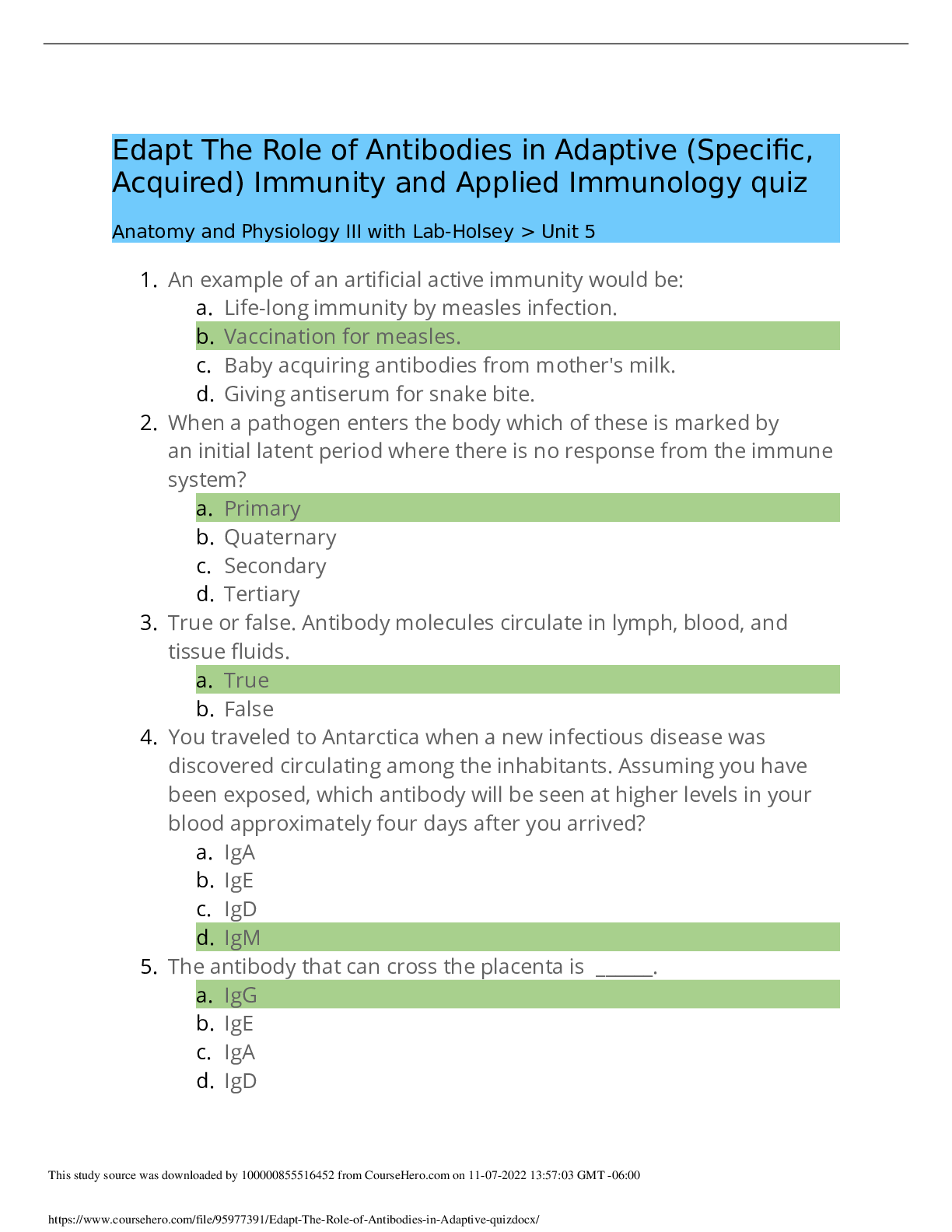
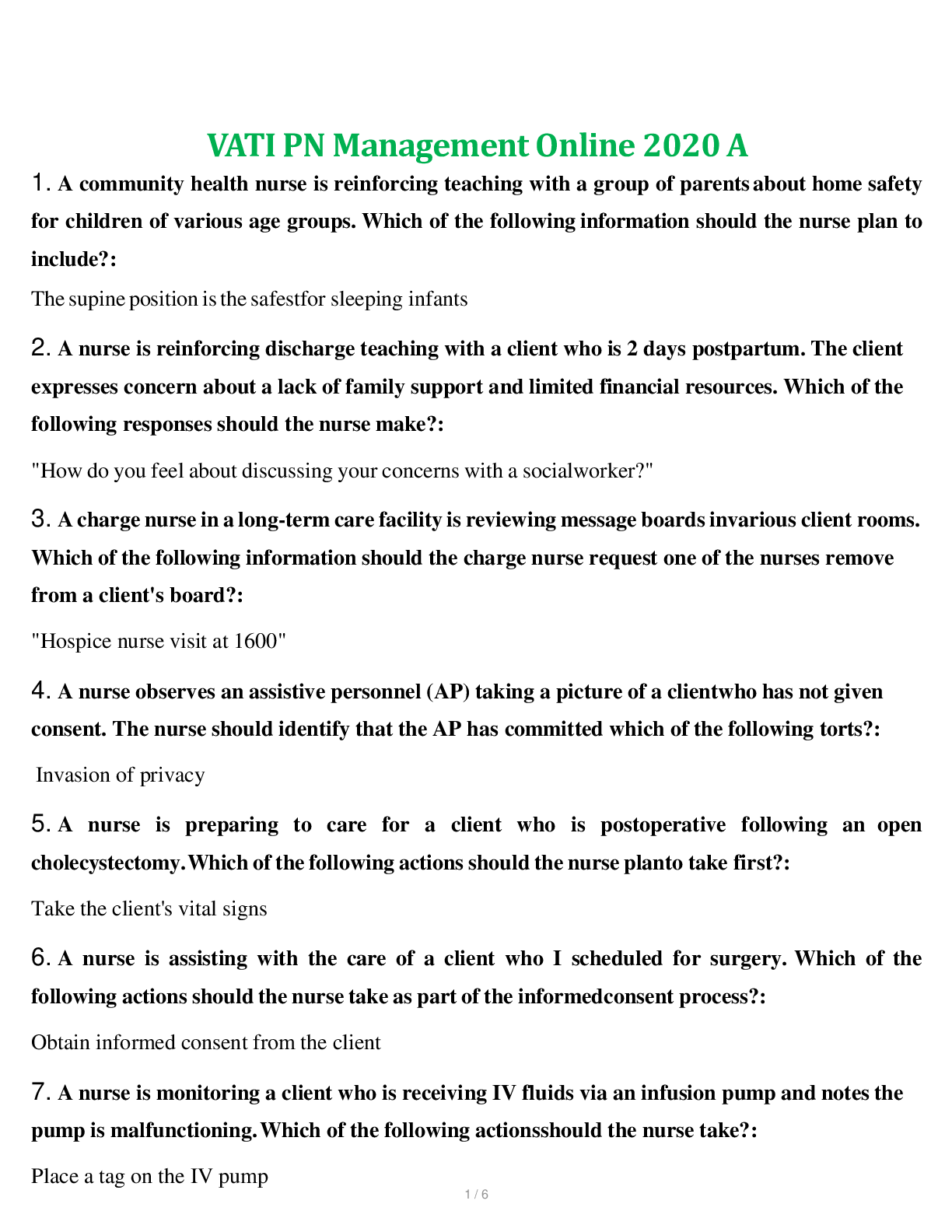
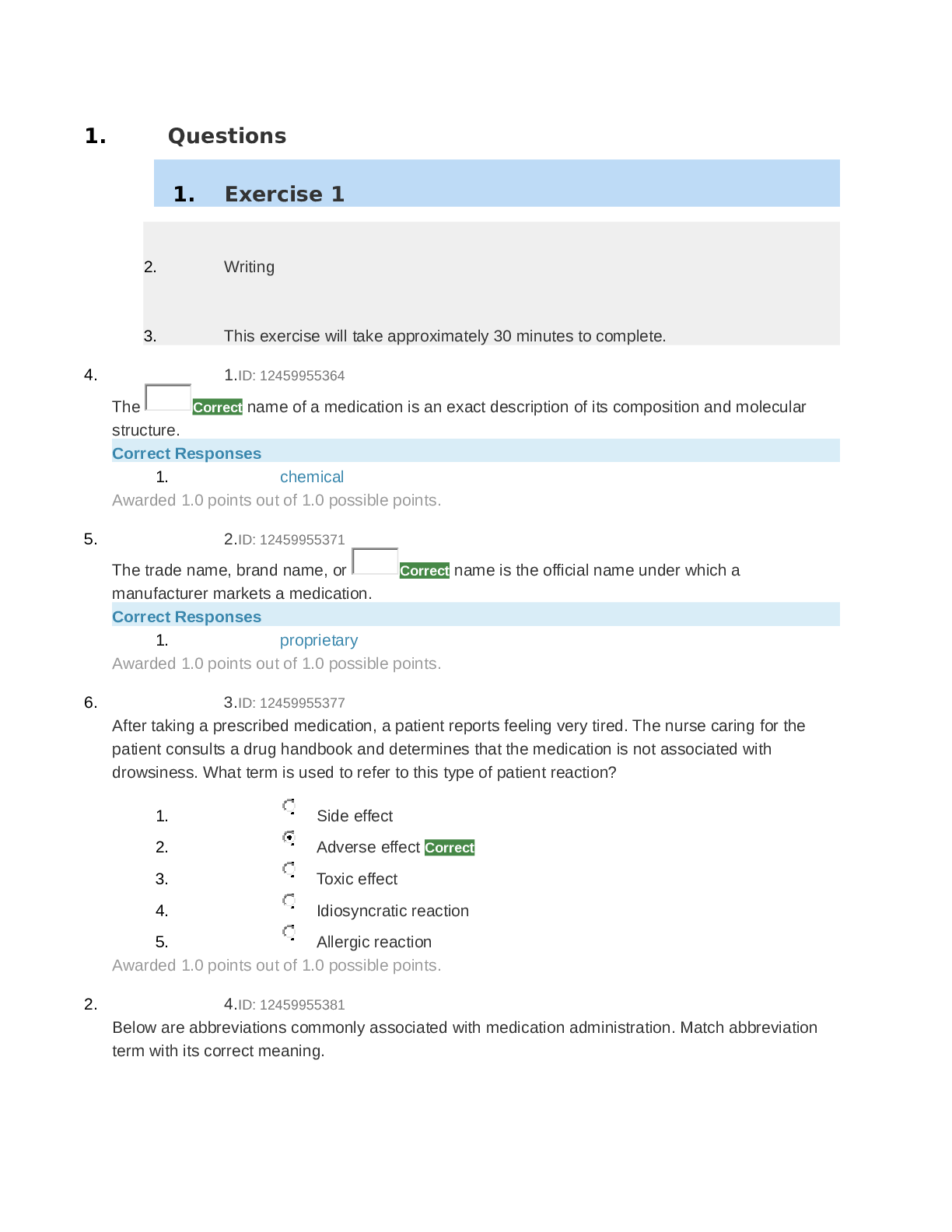

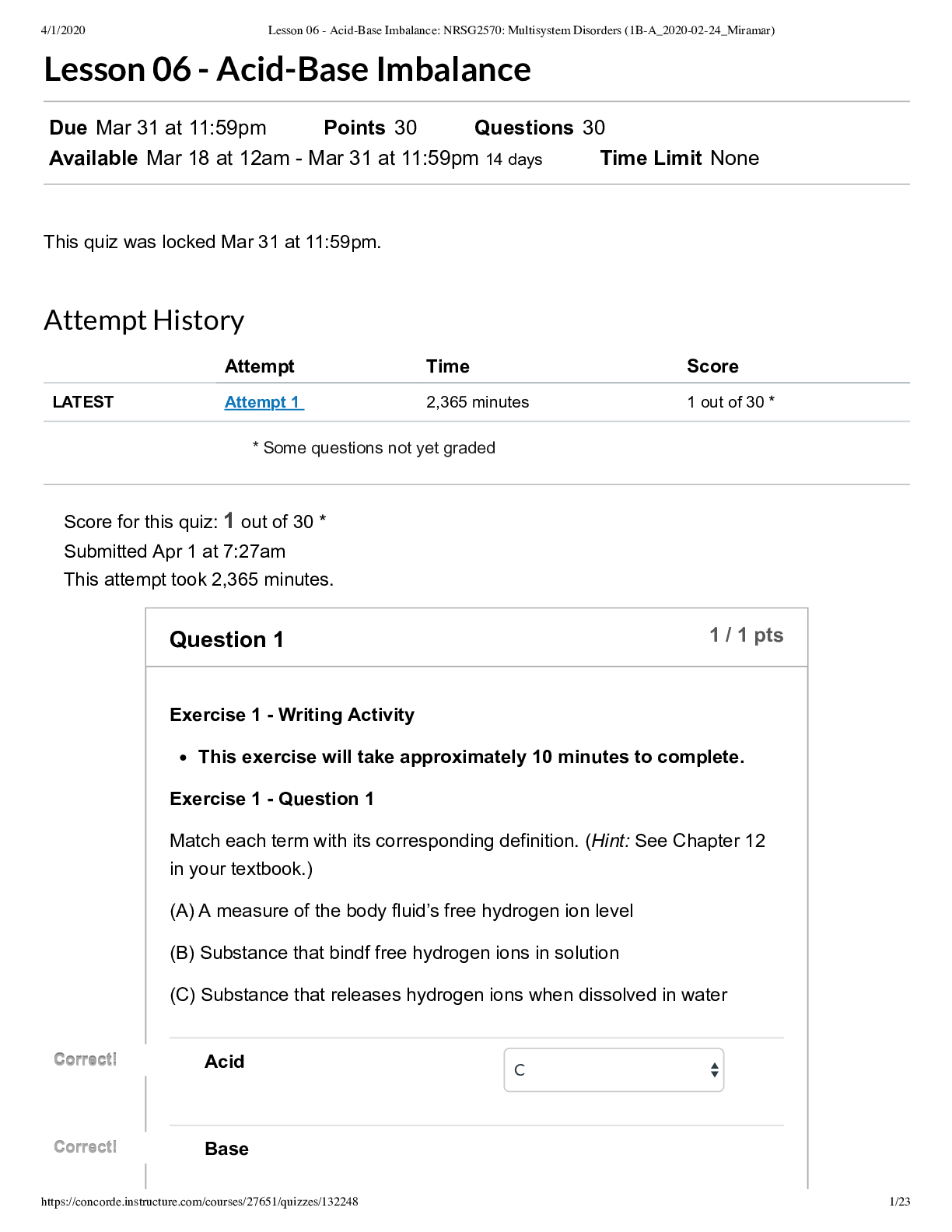


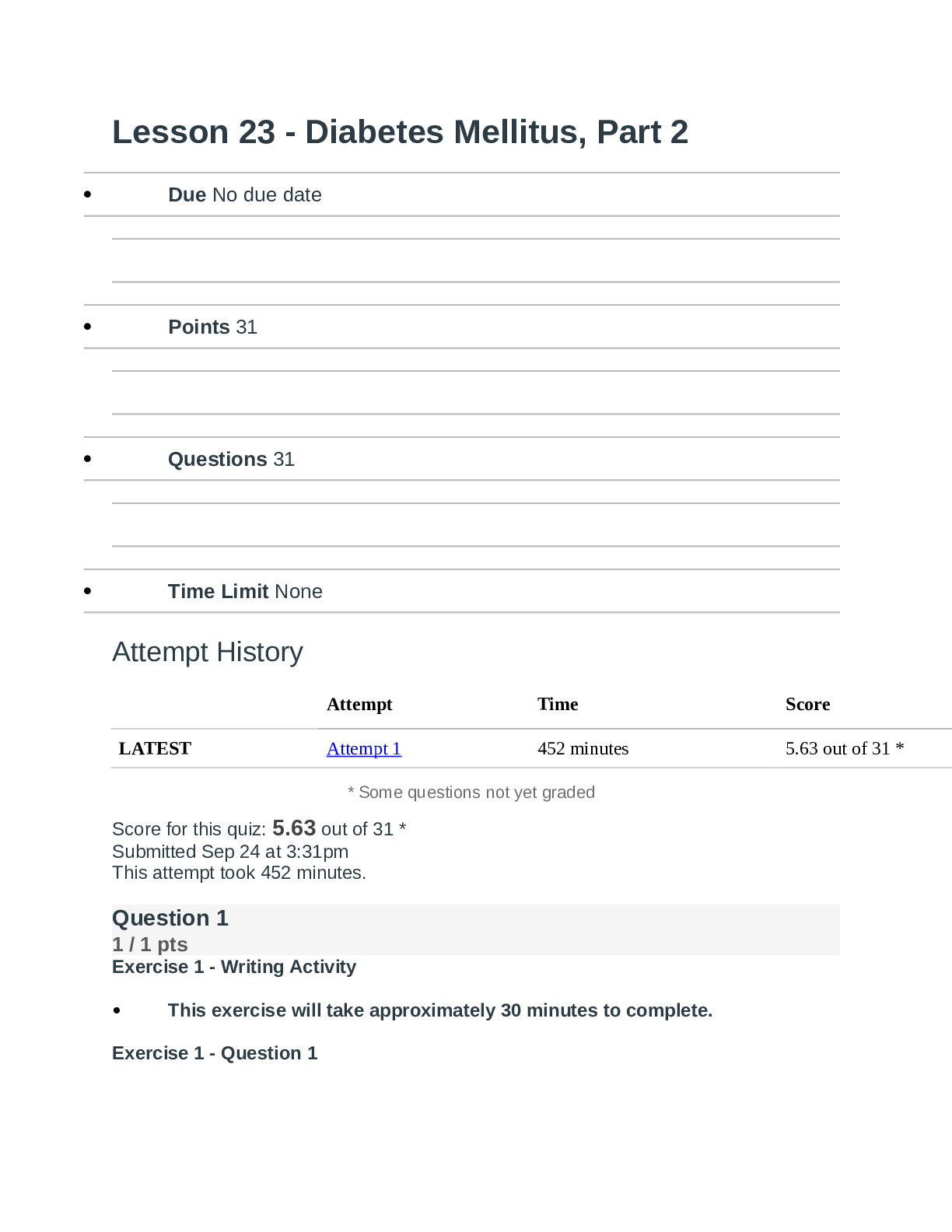
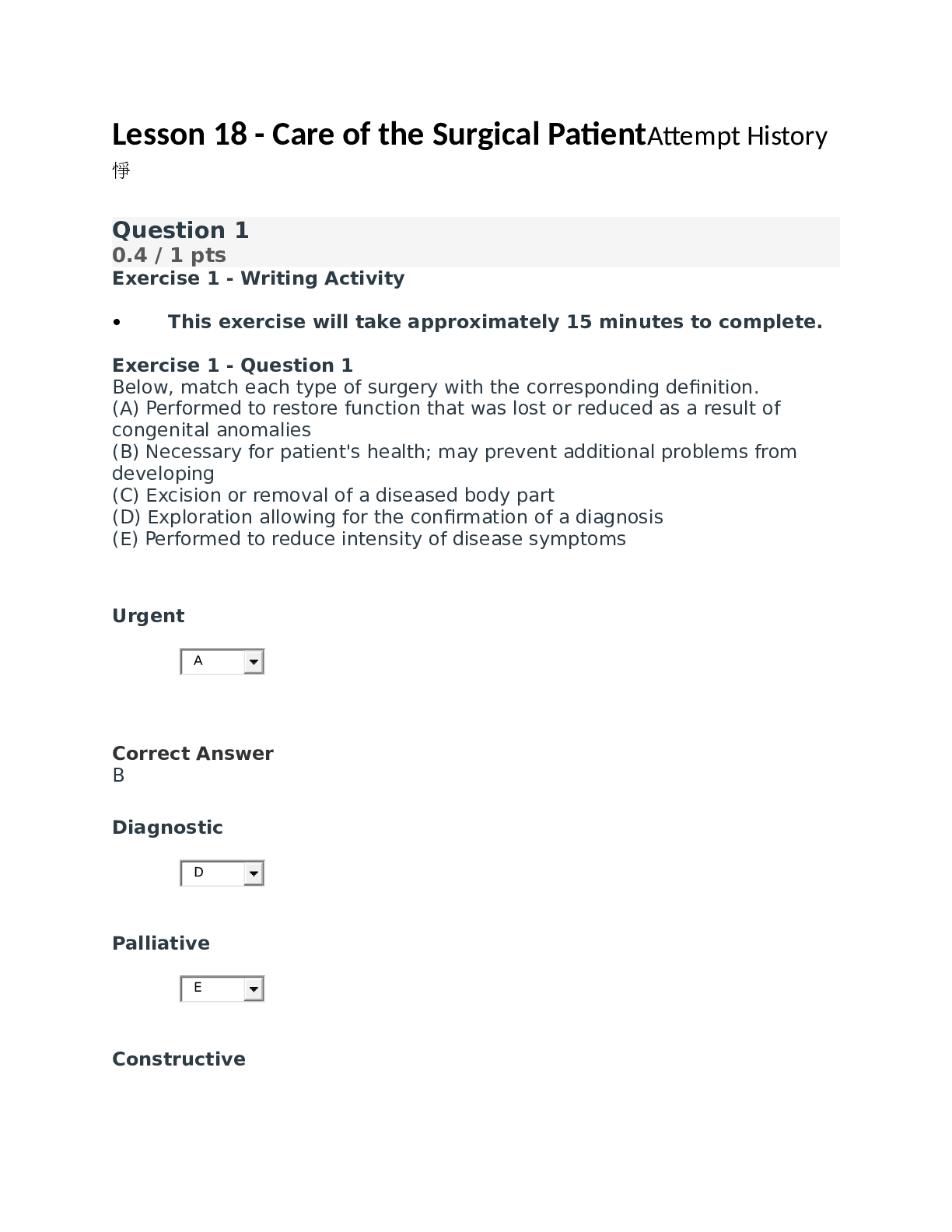
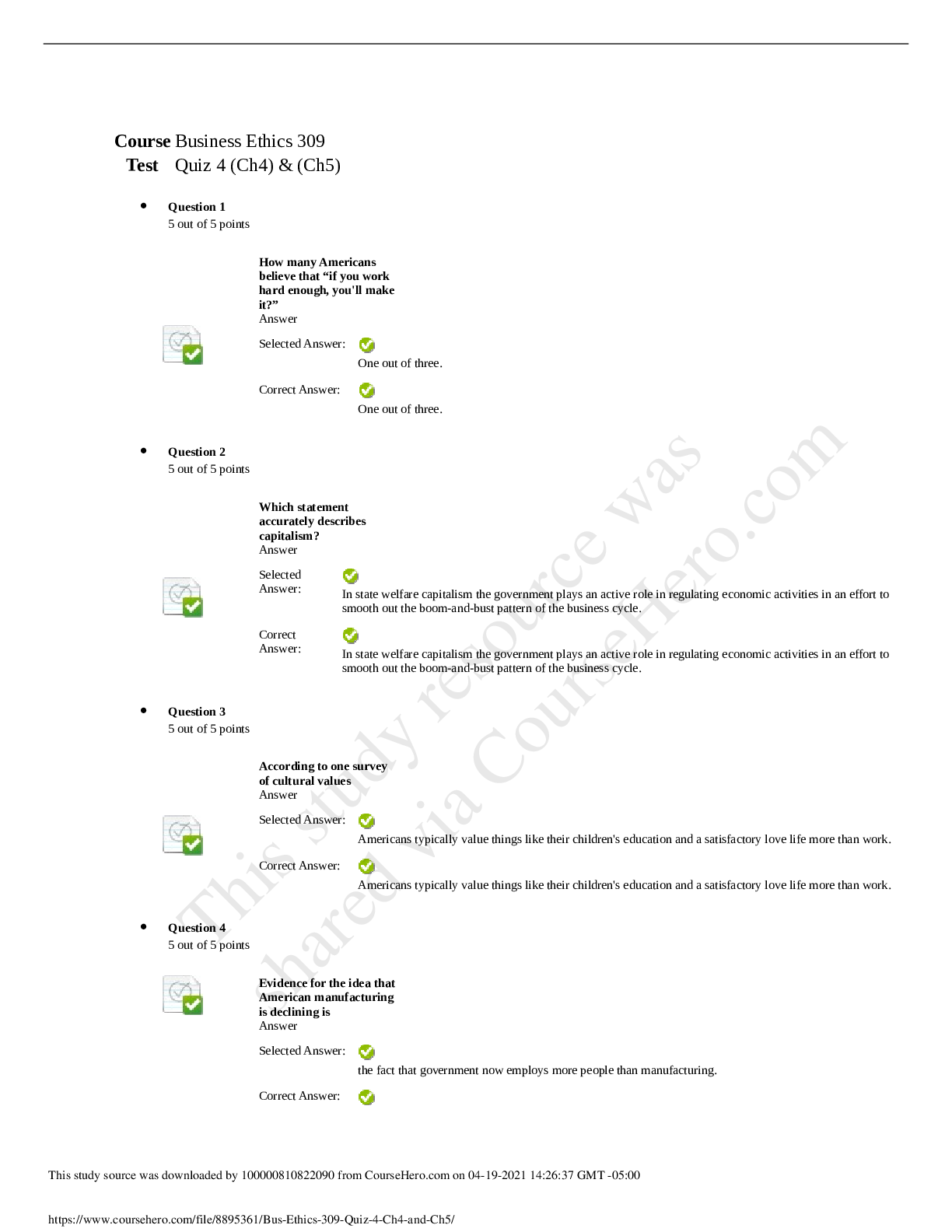

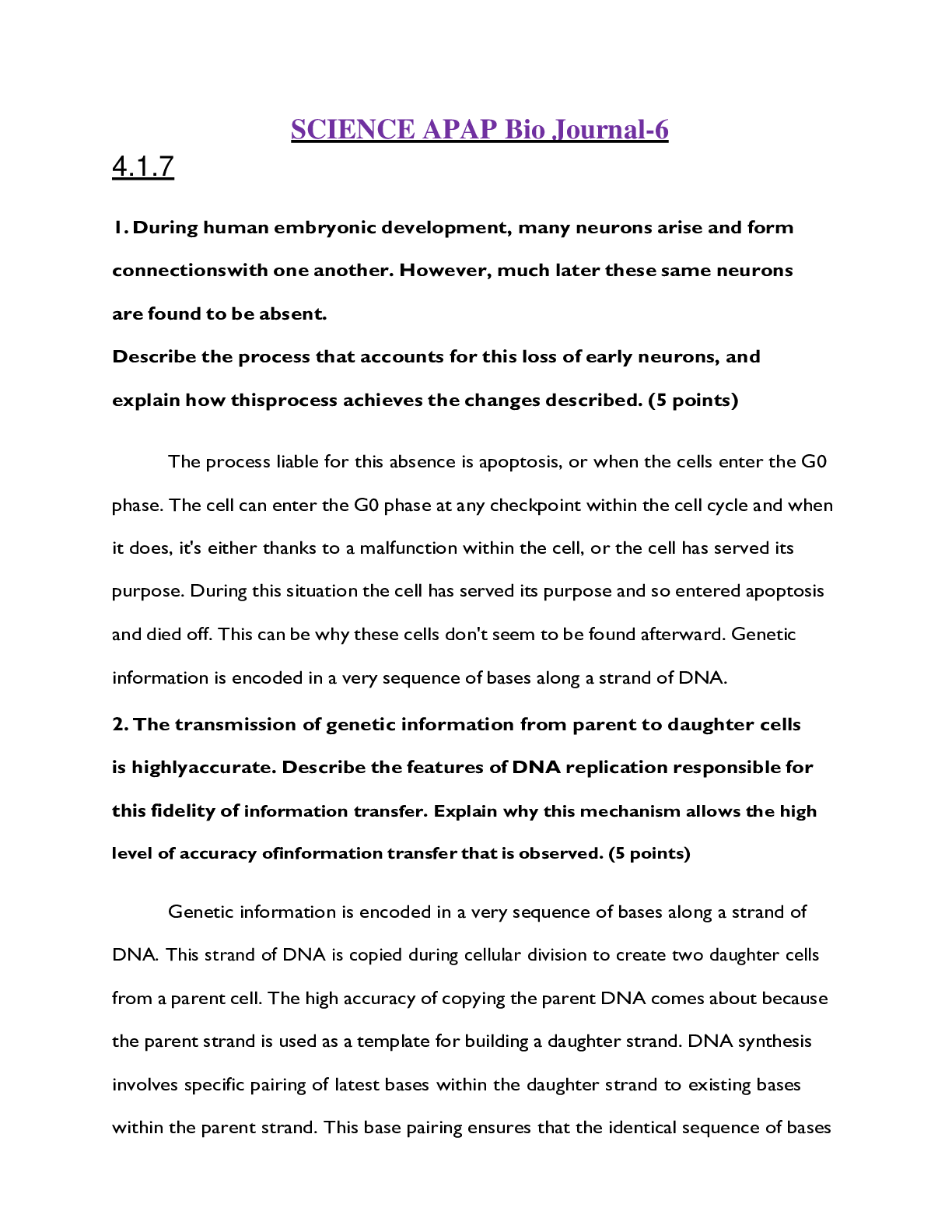
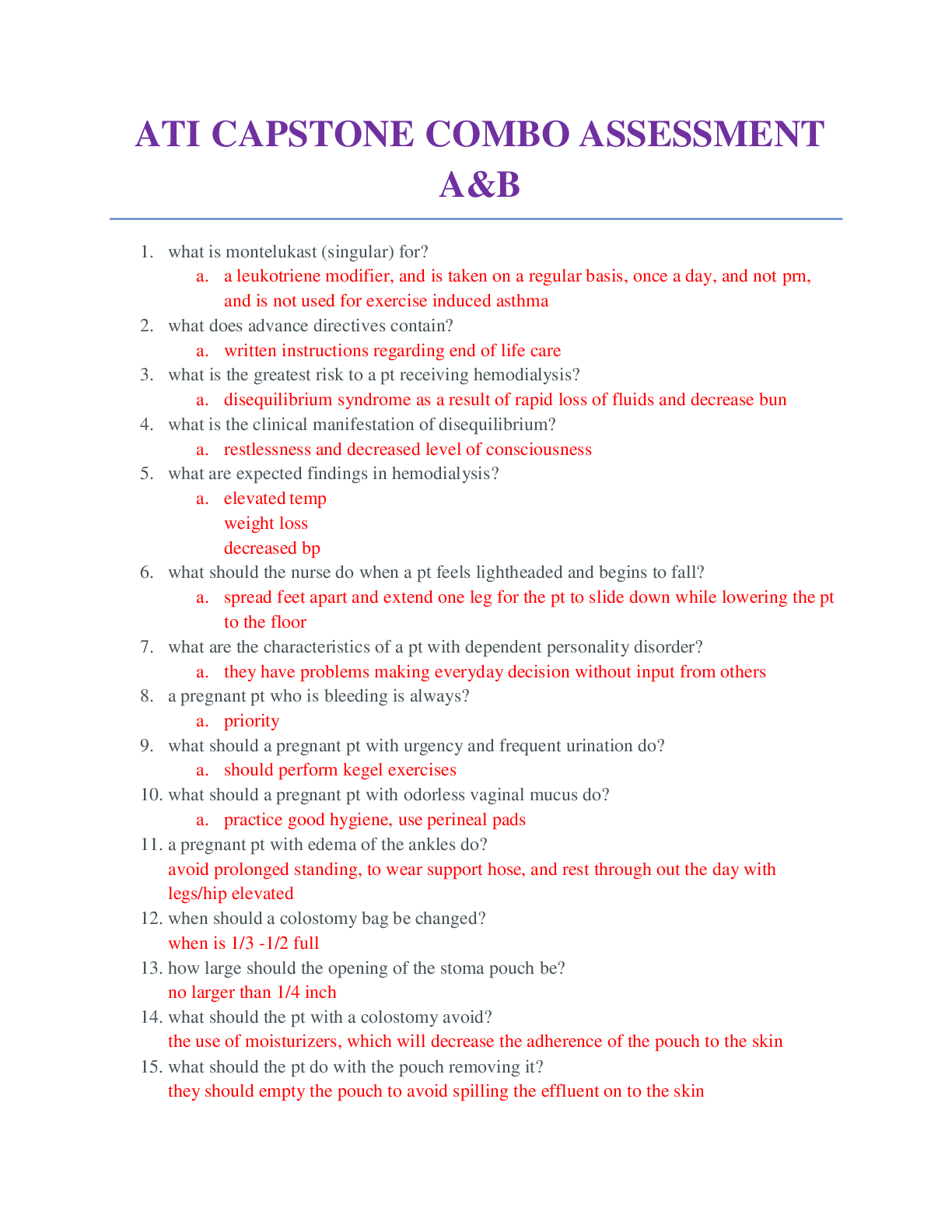
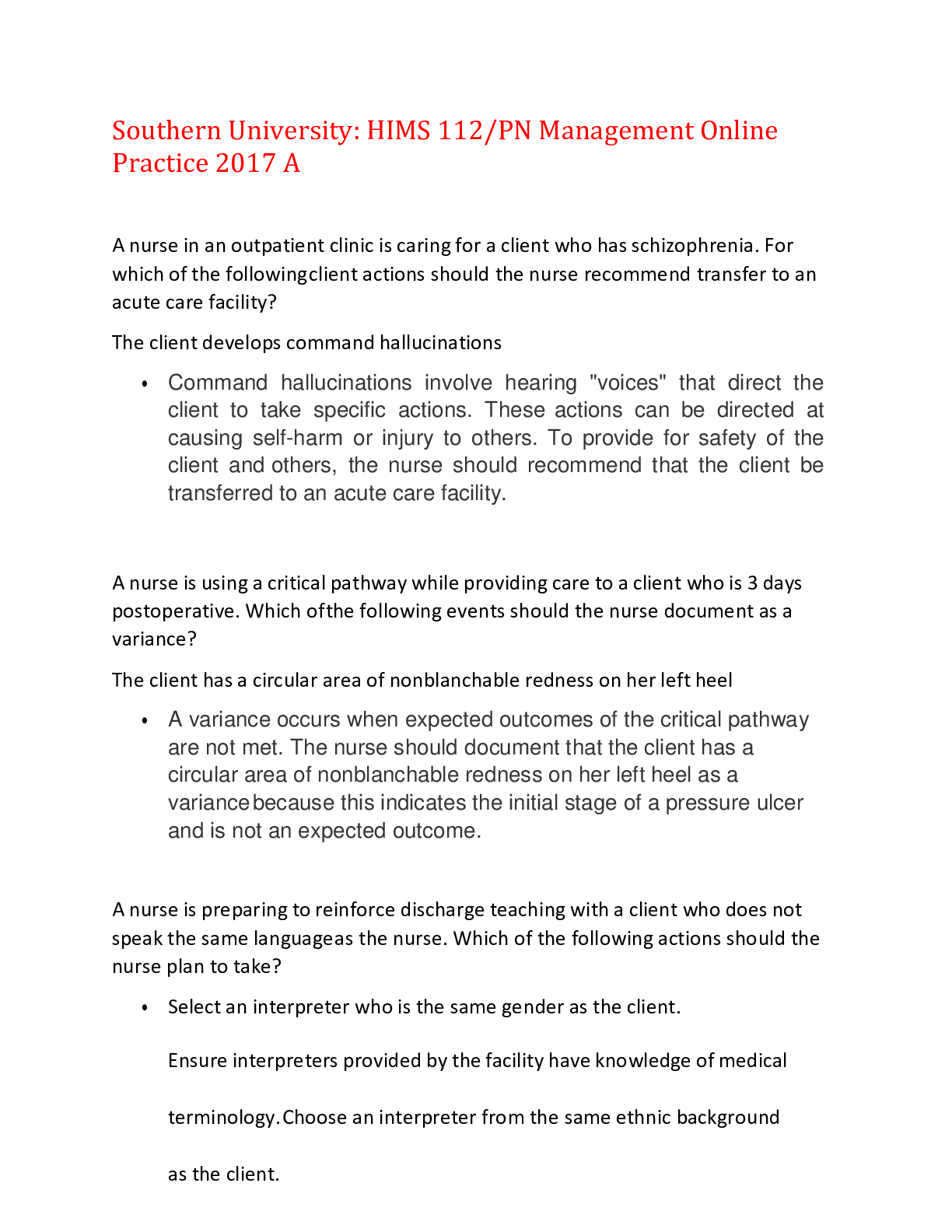
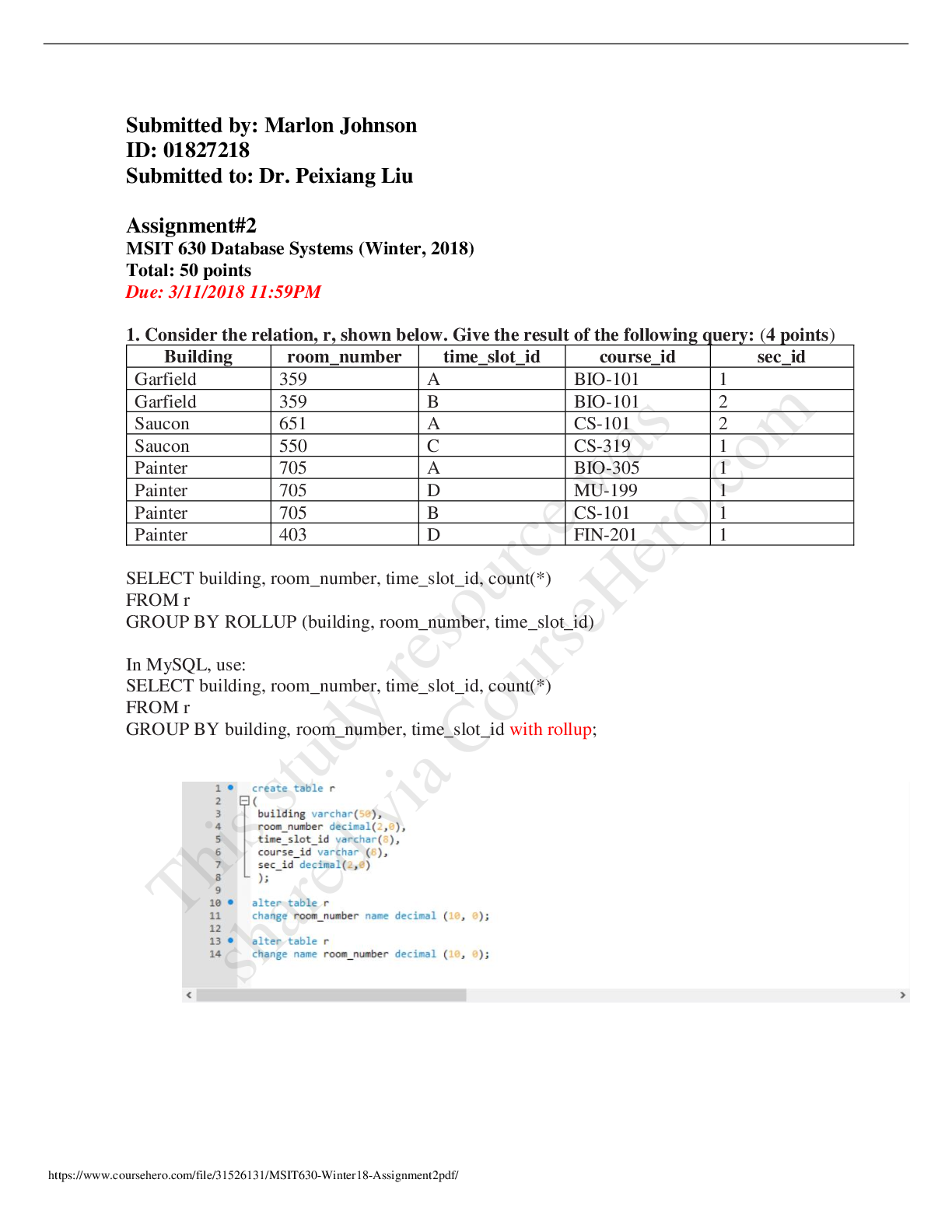


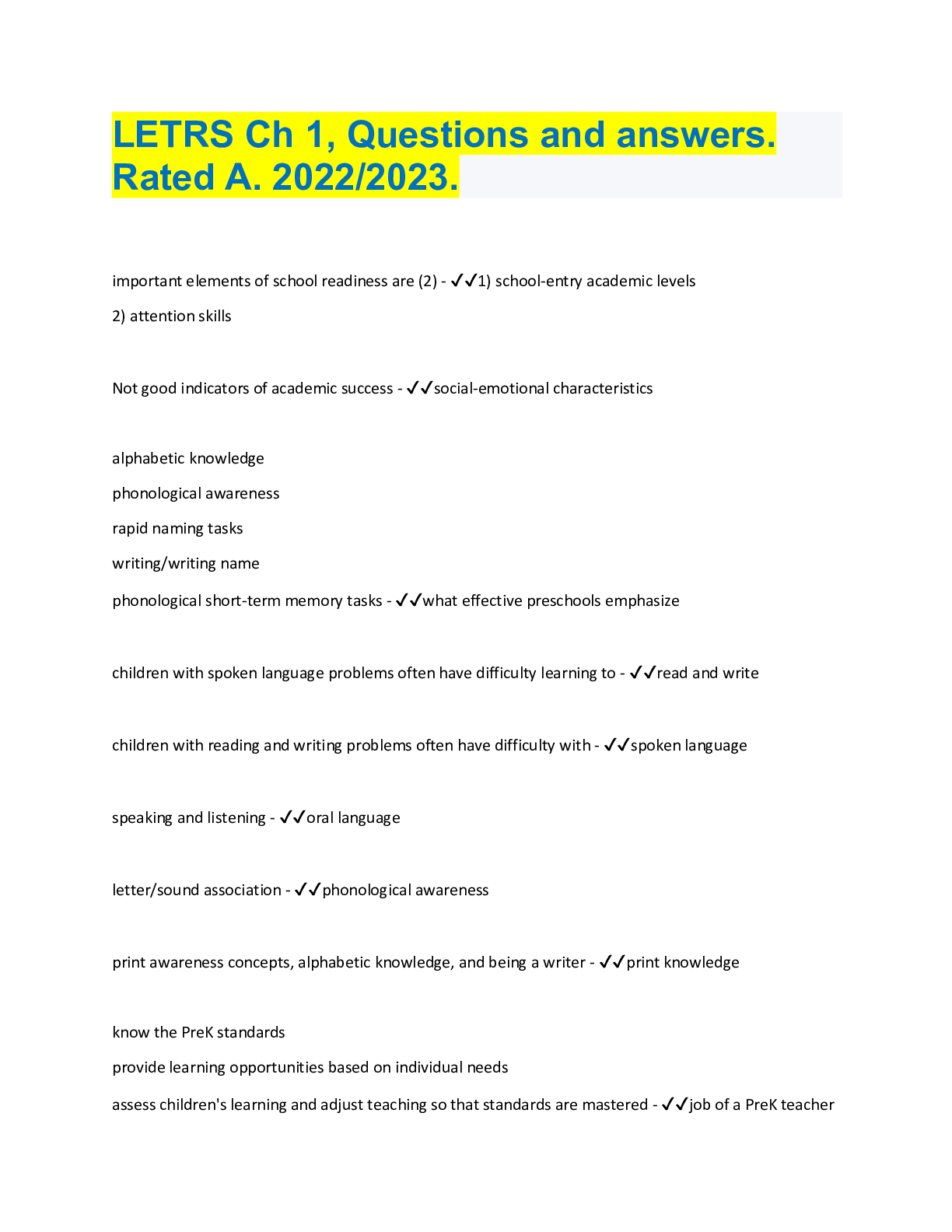
.png)

.png)


